
OX-BOW SCHOOL OF ART & ARTISTS' RESIDENCY
OX-BOW SCHOOL OF ART & ARTISTS’ RESIDENCY
was established in 1910 and continues its mission of connecting artists to a network of creative resources, people, and ideas; an energizing natural environment; and a rich artistic history and vital future. Ox-Bow’s egalitarian and intimate environment encourages all artists, regardless of experience, to find, amplify, rediscover, and share their impulse to create. Faculty, Visiting Artists, Residents, staff, and students live together in a temporary intentional community on our campus in Saugatuck, Michigan, where they share meals, social time, and the exchange of ideas. We actively encourage our participants to engage across differences in age, regional location, race, and gender identity, learning what it means to be a community by participating in one.
MISSION & OVERVIEW
Ox-Bow connects artists to:
• A network of creative resources, people, and ideas
• An energizing natural environment
• A rich artistic history and vital future
OX-BOW TEAM
ADMINISTRATIVE STAFF
Shannon R. Stratton
Executive Director
Claire Arctander
Campus Director
Kathryn Armstrong
Director of Development
Tim Grunwald
Chief Financial Officer, External
Rana Siegel
Director of Administration & Human Resources
Maggie Bandstra Manager of Retail Programs
COMMUNICATIONS
Ashley Freeby Communications Director
Kate Nguyen
Community Manager
Shanley Poole Engagement Liaison & Storyteller
SAUGATUCK CAMPUS
3435 Rupprecht Way PO BOX 216 Saugatuck, MI 49453
HOW TO CONTACT
E-MAIL oxbow@ox-bow.org
PHONE 269-857-5811
OX-BOW HOUSE 137 Center Street PO BOX 758 Douglas, MI 49406
STAY CONNECTED WEBSITE www.ox-bow.org
SOCIAL MEDIA
@oxbowschoolofart
@oxbow_hospitality
PROUDLY AFFILIATED WITH THE SCHOOL OF THE ART INSTITUTE OF CHICAGO, A MAJOR SPONSOR OF OX-BOW

NOTE: All images are courtesy of faculty unless otherwise noted.
CATALOG DESIGN BY: ASHLEY M. FREEBY
PROGRAMMING
Maddie Reyna Academic Program Director
Bobby Gonzales Programs Manager
CULINARY
Nicholas Jirasek Culinary Director
TJ Mathieu Hospitality Manager
FACILITIES & GROUNDS
John Rossi
Facilities Manager
Aaron Cook Operations Manager
Aaron Whitfield Housekeeping Manager
Dove Drury Hornbuckle Ceramics Studio Manager
Please visit our website in May for a complete staff list.
BOARD OF DIRECTORS
Ox-Bow’s Board of Directors contribute their time, expertise, and resources to ensure that future generations of artists will benefit from Ox-Bow’s rich tradition and outstanding programming. We are grateful for their dedication and support.
Steven C. Meier President
Janet R. Cunningham
Secretary & Treasurer
Lucy Minturn Governance Chair
Scott Alfree
Evan Boris
Rhonda Brown
Delinda Collier
Chris Craft
Dawn Gavin
William Padnos
Keith P. Walker
WHERE TO FIND US
2023 SUMMER COURSE CATALOG
A NOTE FROM OX-BOW’S EXECUTIVE DIRECTOR

at Ox-Bow creates those bonds that really endure, connecting artists to a community that will last them a lifetime! Days spent making work together, eating meals together and gathering around the fire pit late at night for those deep talks, are the kinds of days you remember forever, and make for fast friends.
DEAR ARTIST,
Every year I write this letter right as winter is creeping in. I’m looking out at bare branches and gray skies and already dreaming of the summer on campus. If you haven’t been to Ox-Bow before, it might be hard to imagine what you are in store for when you spend the summer with us. It might even be a little nerve-wracking. This year I thought I would tell you a few reasons why taking time away from your routine and the predictable is truly valuable!
First off, Ox-Bow is tucked away down a quiet road on a peninsula. We are surrounded by a 100 acres of forest preserve, with oak trees as old as our campus. The buildings are nestled alongside a lagoon, where you are invited to swim or boat or just admire the sunset. This natural environment is the reason our founders started Ox-Bow: as a respite from city life and a chance to paint (or make any kind of art) outside and under the sun.
Next: community! It can be hard to build and sustain truly transformational relationships during the school year when one is pulled between dozens of responsibilities. Spending 1 or 2 weeks
And of course: transformational learning experiences (and fun!). One of the things we pride ourselves on at Ox-Bow is that our faculty respond to the intensive format with the classes they can’t teach anywhere else. Experimental learning models, time for meaningful mentorship, and being able to create without interruption are all the benefits of learning at Ox-Bow.
Once you try it – you’ll want to come back. And artists do: again and again. Some even stay all summer! We hope you’ll dip your toes in this year and discover what the Ox-Bow experience is all about. If what I just listed doesn’t convince you, then maybe the food might: we feed you 3 meals a day, and I can promise you, you won’t be disappointed by the range of homemade meals and baked goods that our hospitality team cooks up daily.
See you by the lagoon!
Yours,
Shannon R. Stratton, Executive Director

1
My week at Ox-Bow was the highlight of my whole summer! I enjoyed learning an entirely new technical process in Jaclyn’s class that was both challenging and rewarding. I honestly don’t know when or where else I would have been able to come across this unique process! I would recommend it to anyone interested in photography, regardless of level.”
COVER ART BY: Douglas R. Ewart
1. George Floyd Bunt Staff, 2020 Bundt pans, walnut staff, wood burning, plywood, leather, nylon cord, rubber, rubber cane tip and cement, coral, beads, and screws.


72 x 11 x 11 in.
George Floyd Bunt Staff is an idiophone comprising tin and castaluminum Bundt baking pans whose sonic potential and possibilities are incalculable. The construction of these Bunt Staffs is a salute to George Floyd, Everyday Hero in the sense that he is from the neighborhood and was known, loved, and cherished by many in the areas he traversed.
George Floyd bunted, sacrifice flied and punted with his life to open the eyes, hearts, portals, conscience, intelligence, ire, reprimands, demands, and commands that the world’s concept of the police must change. George was murdered in daylight, in Minneapolis Minnesota, however, there are hundreds of George Floyds throughout Planet Earth who are murdered, because of their color, ethnicity, “Race” and designated cast, and economic standing on a daily basis.
2. Truth is Power, The Tongue is Mightier Than The Sword, 2019
Pine and maple woods; buttons; pyrographics: pencil; chicken wire; corn, rubber and wood glues; leather; canvas; acrylic paint; steel nails and screws; brass nails; nylon cords and thread, and plastic.
97 x 7 x 12 in.
This is the nine-sided (nonagon or enneagon) rain stick dedicated to Fanny Lou Hamer, Malcolm X, Deloris Huerta, John Brown, Helen Fennel Joseph, Geronimo, Crazy Horse, Amy Jacques Garvey, Gaspar Yanga, Red Cloud, Vicente Guerrero, Iris Ewart King, Association for the Advancement of Creative Musicians (AACM), Black Artist Group (BAG), American Indian Movement (AIM), Maxeke, and Lozen.

Obsolete wooden bass clarinet, bamboo roots and rhizomes, ostrich egg, fabric, buttons, clarinet reeds, coral, stones, beads, wood glue, nylon cord, screws, and pyrographics.
58 x 15 1⁄₂ x 12 in.
Dedicated to the late Eric Dolphy, the incomparable composer, musician, multi-instrumentalist, conceptualist and visionary, who was an incredibly loving and exemplary human being.
3. Eric Dolphy Sonic Dread, 2017
- Sarah O’Neil, 2022 Silverplate Photography student
1.
2.
2 FOR FACULTY BIOS TURN TO PAGE 32 2023 SUMMER COURSE CATALOG
3.
52 REGISTRATION ROOM & BOARD TUITION & SCHOLARSHIPS POLICIES 57 OUR PROGRAM SUPPORTERS Academic Program Learn more about Ox-Bow Fun stuff The nuts & Bolts 8 GLASS 10 CERAMICS 12 PAINTING & DRAWING 16 PRINTMAKING 18 SCULPTURE & METALS 20 SPECIAL TOPICS 24 ONLINE COURSES 25 THE LEROY NEIMAN FELLOWSHIP PROGRAM 26 COURSE CALENDAR 32 MEET OUR FACULTY 40 MEET OUR VISITING ARTISTS 56 PRE-COLLEGE PROGRAM 1 A NOTE FROM OUR EXECUTIVE DIRECTOR 4, 47 DID YOU KNOW? 44 LIFE AT OX-BOW 55 SUMMER ARTIST-IN-RESIDENCE PROGRAM 28 READ: FROM THE STUDIO TO THE TABLE 49 QUIZ: ARE YOU A TRUE BIRDER? 50 ASTRO FORECAST SUMMER 2023 51 EXPLORE OX-BOW VIA AN INTERACTIVE MAP 3
DID YOU KNOW...
OX-BOW WAS FOUNDED IN... STUDIO BUILDINGS

Ox-Bow House, our community space in downtown Douglas, hosted over a dozen events last year.
OX-BOW'S UNOFFICIAL MASCOT
Samson the snapping turtle...

Legend has it Samson is over a hundred years old.
» Open-air glass and metals studio
» Print studio for lithography, letterpress, silkscreen, and linocut
» Indoor/outdoor ceramics studio featuring a wood-fired kiln.
and is protected through a conservation easement.

acres of dunes, forests, and trails
Ox-Bow’s campus is home to a variety of trees, including BEECH, HEMLOCK, OAK, AND MAPLE
RARE SPECIES KNOWN TO OX-BOW’S CAMPUS
Eastern Box Turtle Pileated Woodpecker

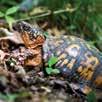
ARE YOU A TRUE BIRDER? TAKE THE QUIZ ON PAGE 49 Blanchard’s Cricket Frog
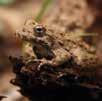 Our campus sits on the TALLMADGE WOODS
Our campus sits on the TALLMADGE WOODS
4 2023 SUMMER COURSE CATALOG BRANDON DILL; NOUNPROJECT.COM: FOREST BY BUHEICON, ; SHUTTERSTOCK.COM: EASTERN BOX TURTLE BY DIMITRIOS PIPPIS, PILEATERD WOODPECKER BYFOTOREQUEST, BLANCHARD'S CRICKET FROG BY RYAN M. BOLTON
SUMMER STATS
MEET THE PROGRAMMING TEAM
MADDIE REYNA Academic Program Director

BOBBY GONZALES Programs
MADDIE REYNA
Manager
Together, Maddie and Bobby make up the Programs Team at Ox-Bow. Both are passionate about cultivating relationships with artist and faculty at their home bases in Chicago, on Ox-Bow’s campus, and beyond. Each year they work to create a one-of-a-kind lineup of courses, fellowships, and residencies. If you see them on campus or at a tabling event in Chicago, don’t be a stranger! They’d love to hear about your practice and they might even give you the scoop on their favorite spots on campus (the lagoon and the Rob!).
Describe your position in one or two sentences?
As Academic Program Director, most of my year is spent forging new and maintaining existing relationships with artists who impact our summer session. Whether faculty, visiting artist, student, or administrator at one of our partner schools, I work closely with all of them to prepare an inspiring summer plan. For 2023, this meant writing 26 new courses to add to our summer catalog. I can’t wait to share it with everyone!
What’s your favorite part of your role?
I love being able to support artists. I’m proud to be a part of an organization that hires over one hundred artists each year to bring their expertise to our participants. When a faculty or visiting artist is inspired by the bounds and realities of Ox-Bow to propose an experience that expands their practice as well as others, I get really excited to help them achieve that goal and share the passion with the participants.
What’s your favorite spot on campus? The hammock along the lagoon outside the glass studio. For years I have been attempting to paint the feeling of laying between those two trees, it’s tough but still exciting.
BOBBY GONZALES
Describe your position in one or two sentences?
I am the Manager of Academic Programs at Ox-Bow, which involves a fair amount of registrar-type duties, as well as building courses and recruiting faculty to teach.

You can often find me on the 2nd floor of the Sharp building at SAIC on Friday afternoons - helping enroll students and giving out information about Ox!
What’s your favorite part of your role? My favorite part of the job is connecting artists with our residency and fellowship programs.
What’s your favorite spot on campus? My favorite spot on campus is after hours at the Rob!
GOT QUESTIONS ABOUT HOW TO START YOUR ACADEMIC JOURNEY AT OX-BOW?
You can find Maddie and Bobby frequently on SAIC's campus or email your questions to oxbow@ox-bow.org
67 FACULTY MEMBERS 30 RETURNING FACULTY 37 ARE NEW FACULTY
12 FELLOWS 12 RESIDENTS 17 RETURNING + 29 NEW = 46 COURSES 12 VISITING ARTISTS 350 anticipated number of students in 2023
5
2023 academic program
Ox-Bow School of Art & Artists’ Residency has a rich history of connecting artists to new skills, supportive mentors, and inspiring nature. Our Summer 2023 Core Academic Program features a record-breaking 26 new courses that celebrate the natural rhythms of learning at Ox-Bow and invite participants to bang a new drum, stay up all night, and explore fresh perspectives. We are excited for you to join us and engage Ox-Bow’s unique ability to host classes that bridge craft and concept, merge play and focus, and allow students to explore new techniques in a 1-, or 2-, week setting.
All Core Courses are open to anyone over 18 and are available as for-credit or non-credit enrollments. Class meets everyday during the session, including any weekend, from 10:00 AM - 5:30 PM. During each session, Ox-Bow hosts an exciting calendar of events after class hours including visiting artist lectures, spontaneous workshops, and socials.
8 GLASS 10 CERAMICS 12 PAINTING & DRAWING 16 PRINTMAKING 18 SCULPTURE & METALS 20 SPECIAL TOPICS 24 ONLINE COURSES 6 2023 SUMMER COURSE CATALOG

Minhi England, Blue Breath , 2022, blown and hot sculpted
15 x 6 x 6 in.
glass,
GLASSBLOWING


with
Yashodhar Reddy & Will Hutchinson
SCULPTURE | 681 001 | 3 CREDITS

$350 LAB FEE | JUNE 11 - 24
This course will cover the fundamentals of glassblowing and is designed to develop a student’s foundational knowledge and skill upon which more advanced ideas can be built. Students will learn to gather hot glass out of the furnace and how to manipulate it with a variety of tools and techniques in both the hot shop and the cold shop. Productive practices including working as a team, timing and choreography, and using natural elements to execute ideas will be demonstrated. This course may include readings from Ed Schmidt’s Beginning Glassblowing and a screening of Glassmakers of Herat. We will investigate glassblowing from a historical approach and look at objects from different periods in history, including works made by Pino Signoretto, Bill Gudenrath, and Karen Willinbrink-Johnsen. Assignments will range from functional cup making, executing complex abstractions, and methods for coloring and patterning. This course will culminate in the completion of a student designed sculpture or installation to be exhibited in the hot shop.
STRIPES: INTRODUCTION TO CANE MAKING
with Matt Urban
SCULPTURE | 679 001 | 3 CREDITS

$175 LAB FEE | JUNE 25 - JULY 1
In addition to being one of the most stunning techniques for working with color, cane production is a useful tool in understanding the natural properties of glass in a molten state. In this course, students will learn the cane making process in the hot shop and explore how this visual element operates between geometry and elegance. We will start with basic techniques of pulling long ropes of multi-colored cane and build towards elaborate compositions. As a group, we will discuss our successes and failures in service on a deeper understanding of the medium and will study historical examples. Demonstrations will lead students through helpful methods for keeping their cane making on track, and how to apply it to their glass projects. Students will maintain a sketchbook for their ideas and this course will culminate in an exciting display of finished pieces.
FLAMEWORKING: FINDING FORM IN TRANSLATION

with
Carmen Lozar
SCULPTURE | 649 001 | 3 CREDITS
$175 LAB FEE | JUNE 25 - JULY 1
This class is an introduction to working and thinking with glass. Focused on contextualizing flameworking within contemporary sculpture, this workshop is ideal for artists crossing over from other disciplines who would like to translate their ideas into glass. The goal of the class is to complete two finished sculptures, which are both structurally sound and conceptually tight. Blending traditional and unconventional flameworking techniques, students are encouraged to explore the material and expand their artistic vocabulary. We will consider the material qualities of glass in the context of drawing, painting, sculpture, and performance. Students can use glass as an opportunity to connect materiality to related disciplines such as literature, psychology, optics, poetry, and architecture. The coursework will include a combination of technical exercises designed to improve hand skills, contextual presentations, and group critique.
(clockwise from top left) 1. Yashodhar Reddy, Pink Vases and Cups, 2021, glass, 3 x 12 in. (tallest), 5 1/2 x 2 1/2 in. (widest); 2. Liesl Schubel, The Moon Grounded (Patti), 2018, glass and rooster wings, 6 in. round; 3. Carmen Lozar, Oil Spill, 2018, glass and mixed media, 5 3/4 x 13 x 15 in.;
8 2023 SUMMER COURSE CATALOG
4. Matthew Urban, Fancy cups, 2022, glass, 20 in. tall; 5. Will Hutchinson, jar, 2022, blown glass
QUEER METHODS IN GLASS & PRINT


with H Schenck & Liesl Schubel
SCULPTURE & PRINT | 680 001
3 CREDITS | $350 LAB FEE
JULY 10 - 22
This cross-disciplinary course will be hosted in both the print studio and glassblowing studio and encourages experimental making processes that blur image, language, and sculpture. Taking inspiration from printmaking’s origins in published activism, and glassblowing’s inherent denial of binaries as an amorphous solid, students will self-innovate the basic principles of each process, dissolving the boundary between media, to create a collection of objects and images with glass. Students will learn the process of vitreography, a technique for fixing an image within a sheet of float glass to create an impression on paper. In the glass studio, foundational glassblowing skills will lead to more complex shapes, including rondels and cylinders for custom flat glass, and more flowing, unusual forms. We will consider artists who generate language and instigate play, including Anna Mlasowsky, Victoria Ahmadizadeh Melendez, and Elizabeth Atterbury, while reading “Daybook” by Anne Truit
and “Learning to Love You More” by Miranda July. We will also host/ discuss screenings about Jes Fan and Amos Paul Kennedy Jr. To maximize cross-studio collaboration, students enrolled in this course will alternate back and forth between the printmaking and glass spaces. In addition to vitreography exercises, assignments will include pyrographic drawings and glass capsules and the course will culminate with salonstyle installations of created and found objects.
MULTI-LEVEL GLASSBLOWING

with Minhi England & Bri Chesler
SCULPTURE | 641 001 | 1.5 CREDITS
$175 LAB FEE | JULY 23 - 29
A hands-on studio workshop for those with some glassblowing experience. Students will learn a variety of techniques for manipulating molten “hot glass” into vessel or sculptural forms. Lectures, demonstrations, videos, and critiques will augment studio instruction.
THE DINNER PARTY
with Corey
Pemberton
SCULPTURE | 676 001 | 3 CREDITS

$350 LAB FEE | JULY 30 - AUGUST 12
There’s nothing more satisfying than eating and drinking from handmade wares with friends. This course, open to students of all levels, will focus on establishing a strong foundation in form and function in service of manipulating molten glass into items for a communal table setting. We will learn the processes involved in making objects including drinkware, pitchers, serving bowls, plates, and candlesticks and consider the works of Judy Chicago, Beth Lipman, and Joe Cariati. Underscoring the social nature of the glassblowing process in the studio, our objective will be to create a tablescape to use for a social mixer at the end of the class, bringing everyone together to celebrate one another’s hard work and individuality. Students need only bring a good attitude, an open mind, and a hunger to learn!
LIGHT(NING) IN A BOTTLE
with
Lucy Gillis
SCULPTURE | 682 001 | 3 CREDITS
$350 LAB FEE | AUGUST 13 - 26
TURN TO PAGE 28 TO READ
From
In this course we will observe an experimental approach to glass making and emphasize its singular, magical effects on natural and artificial light as well as its uses in photography. We will make solid and hollow forms in the hot shop, including basic lenses and spheres or marbles, considering how the finished objects will interact with light. Further manipulation of these objects in the studio through cold processes such as low tech “mirroring,” cutting, and layering will also be explored. We will take inspiration from artists working with striking light and color glassworks including Hank Adams, Mark Dion, Felix Gonzalez-Torres, and Yayoi Kusama. Using our glass objects, along with other translucent and foraged items, we will create unique cyanotypes. While this course will be grounded by the ephemeral existence of light, we will conclude with a collection and presentation of glass objects and unique cyanotypes, as well as an expanded understanding of glass and its power in art.
(clockwise from top left) 1. H Schenck, spoil board and finger study, 2021, monoprint, Reeves heavy weight BFK, poplar, 25 x 32.5 in.; 2. Bri Chesler, Bruised Brute, 2020, glass and mixed media, wall installation, 33 x 35 x 21 in.; 3. Corey Pemberton, Salad Bowls, 2018, blown glass, 12 in.; 4. Lucy Gillis, Never Enough, 2020 , glass tube with argon gas, electricity, 30 x 36 in.
9 FOR FACULTY BIOS TURN TO PAGE 32
The Studio to the Table a story about Corey Pemberton's first-time teaching at Ox-Bow.
FLORA, FAUNA, FIGURE, & NARRATIVE
with Salvador Jiménez Flores & KC Weldon
CERAMICS | 651 001 | 3 CREDITS
$225 LAB FEE | MAY 28 - JUNE 10
This class engages with the form and content of flora and fauna through figurative ceramics. Throughout history, artists have used plant and animal life as tools for narrative and as modes of expression to represent the conflicts and connections between living things. Notions of the wild and domestic merge and are reflected in processes like taxidermy, idealized floral prints, and in the process of firing raw clay into ceramic objects. From mythical narratives to hyper-realist practices, representations of plant and animal life can create possibilities for new stories, meanings, and identities. Students will explore various hand-building methods, basic surface application, and assemblage to discuss their interest in culture, storytelling, and self-identity. Works by artists including Kiki Smith, Marcus Kenney, Firelei Baez, Alesandro Gallo, and others will act as points of departure for our work in this course. Some of the scholars we will study in this course include France de Waal and Homi K. Bhabha. Through demonstrations, slides, in-class activities, readings, and group discussions, this course will provide a productive and critical space for making. Class conversations will focus on the content and context of student work. Students should expect to produce 2-3 finished sculptures during the semester, to be presented in a culminating course critique.
WOODFIRE: ANCIENT METHODS & CONTEMPORARY APPLICATIONS
with Henry Crissman & Virginia Rose Torrence
CERAMICS | 660 001 | 3
CREDITS
$250 LAB FEE | JUNE 11 - 24
This course will explore the many histories, methods, and potentials of using wood as fuel to heat and transform clay into ceramic. Presentations will survey ceramic science, the history and logic of kiln design, and the range of objects made with wood fired kilns. Demonstrations will include handbuilding and wheel throwing techniques as well as experimental
methods with found ceramic materials and objects. Films and readings including Maria Martinez: Indian Pottery of San Ildefonso and Robin Wal Kimmerer’s ‘Braiding Sweetgrass’ will offer insights as we engage and form the material of the Earth. Conversations throughout will aim to assist students in finding creative agency with ceramics. Students will work on independent projects and the class will culminate in a nearly two day long firing of Ox-Bow’s 50 cubic foot catenary-arch wood-kiln; a massive group effort that will involve loading the kiln, and methodically stoking it with wood for the duration of the firing until our desired temperature is reached throughout. While the kiln cools we’ll explore ways in which the techniques covered might be applied outside of the workshop, and build and fire a small and temporary kiln which students could easily recreate independently. Once cool, the big kiln will be unloaded and cleaned, results will be finished and analyzed, and we’ll hold an exhibit of the works created.
THE ANCIENT FUTURE: CLAY & SOUND
with Israel Davis & Douglas R. Ewart
CERAMICS | 659 001 | 3 CREDITS
$225 LAB FEE | JULY 10 - 22
Music and clay, are two of the most malleable, elastic, enduring, widely utilized, and shared materials and experiences known to the Human Family. Many of the oldest musical instruments found at archeological sites are made of clay and, inspired by this ancient relationship, we will study the symbiotic nature of ceramics and sound through instrument making and performance. We will explore music and clay as medicine for meditation, comfort, and peace through the creation of ceramic drums, shakers, whistles, cups, bowls, and as carriers of sound, food, and libation. The works of Raven Halfmoon, Dante K. Hayes, and Ebi Baralaye may guide our creative path and we will review the ceramic instrument works of Nigeria, Pakistan, Morocco, and Turkey. Through daily musical improvisations, guided sessions, group discussions, and demonstrations on ceramic studio processes including hand-building, throwing, and glazing techniques, this course will culminate in pit fire and a final performance. We aim to share in meaningful exchange that reexamines ancient practices as a way to forge new pathways to cultural wellness.
THE EMOTIONAL ALCHEMIST: COLORED CLAY & GLAZE LAB
with
Ling Chun & Amanda Salov
CERAMICS | 661 001 | 3 CREDITS
$225 LAB FEE
JULY 30 - AUGUST 12
This course will introduce students to a variety of exciting methods to bring color into their ceramics. Methods will include introducing stains and oxide stains onto clay bodies and glazes. By creating our own measurement of color, we will produce a visual color-aid to process, share ideas, and represent emotions. We will look into ceramic history and investigate how scientists and artists find ways to measure and apply color in their wares. Examples will include the cyanometer, a 225-yearold hue measuring tool for the sky and Nerikomi, a traditional Japanese colored clay method. Students will learn how to concoct inclusive stains into their clay body, and work through the process of understanding glaze through a series of testing methods including line blends & triaxial blends. This course will end in the presentation of successfully fired pieces.
MOSAICS IN STRATA
with Dove Hornbuckle & E. Saffronia Downing
CERAMICS | 658 001 | 3 CREDITS
$300 LAB FEE | AUGUST 13 - 26
In this course, students will produce handcrafted ceramic tiles, forage for ceramic materials, and gain knowledge on material ecologies. Students will be taught techniques in tile making including slab making, reusing ceramic residue, and various methods in surface design. Taking advantage of the unique setting of Ox-Bow, we will forage for materials from local clay deposits and transform them in the ceramics studio. Students in this course may make mosaic sculptural pieces utilizing their handmade tiles. This class will be informed by the work of artists including Nek Chand, Isaiah Zagar, and Mary Nohl. Readings can include Carrier Bag Theory by Ursula Le Guin. Assignments will include tile making, surface treatment exercises, ceramic recycling methods, and discussion.
10 2023 SUMMER COURSE CATALOG FOR FACULTY BIOS TURN TO PAGE 32
1. E. Saffronia Downing, Path Star (Variation), 2022, Risograph prints of foraging sites, earthenware, glass and stones from Chicago, Baltimore, Steuben, Waterville, stoneware, glaze, 4 x 4 ft.


2. Salvador Jiménez-Flores, A Hand Gesture to Systemic Racism: Al que le quede el saco que se lo ponga, 2022, earthenware, stoneware, black stain, underglaze, glaze, wood, steel, graphite, and latex paint, 96 x 60 x 20 in.
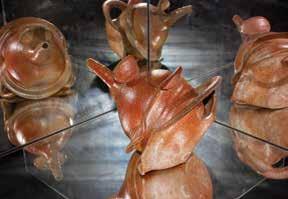

3. Virginia Rose Torrence, Untitled, 2018, ceramics, glass, found objects, on wood, 11 x 8 in.

4. Israel Davis, Mining the Echoes Series: Incumbent Beyond, 2022, Wall-hung, ceramic tile mounted on painted plywood with hanging wire, 5lb., digitally generated images, screen-printed underglaze on earthenware, ceramic toner decals, 11 x 10 x 1 1/2 in.

5. Douglas R. Ewart, Truth is Power, The Tongue is Mightier Than The Sword, 2019, pine and maple woods; buttons; pyrographics: pencil; chicken wire; corn, rubber and wood glues; leather; canvas; acrylic paint; steel nails and screws; brass nails; nylon cords and thread, and plastic, 97 x 7 x 12 in.

6. KC Weldon, Prey, 2022, ceramic, 13 x 6 x 7 in.

7. Dove Hornbuckle, Self-Control, 2020, stoneware, glaze, 21 x 13 x 18 in.
8. Amanda Salov; Morning Light, 2020, porcelain, pigment, brass, cable; 3 ft. wide, height varies

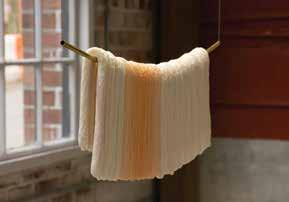
9. Henry J.H. Crissman, Untitled Teapot, 2021, wood-fired ceramic, 8 x 7 x 9 in.
10. Ling Chun, Bright Moon, 2021, ceramics, 4 1/2 x 4 x 4 in.
(Left to right from top left)
COVER ARTIST 11
PAINT MAKERSPACE
with Laurel Sparks
PAINTING | 669 001 | 3 CREDITS
$50 LAB FEE | MAY 28 - JUNE 10
This survey course provides students of all levels with the opportunity to work on their own projects and expand their painting skills. Students will have dedicated access to the painting studio and will be encouraged to experiment with various materials and techniques. Demonstrations may present techniques in acrylic or oil, sketching and planning processes, preparation of painting surfaces, and information on studio safety. The faculty will host presentations and lectures on relevant historical artists as well as contemporary painters, and students will engage in discussions, readings, screenings, and critiques with the group which illuminate painterly concerns and emphasize active decision making. Assignments are designed to build understanding of new methods, and students will conceive projects that reflect their interests. Instructors will be available to help facilitate individual, collaborative, and interdisciplinary projects and this course will culminate in a group critique.
RITUAL EMBRACE
with Ruby T
PAINTING | 674 001 | 3 CREDITS
$50 LAB FEE | MAY 28 - JUNE 10
Based in drawing, this course nurtures individual studio practices of any discipline via ritual exercises in the Ox-Bow landscape. Both drawing and ritual are ancient strategies for expression and survival. Ritual and
magic have in recent decades joined drawing as recognized methods of contemporary artistic production. How can we use drawing and ritual to strengthen our respective artistic practices and spark exciting and unexpected moves in the studio?
For inspiration and guidance, we will look to the paintings, drawings, and earthworks of Torkwase Dyson, Hilma Af Klint, Ana Mendieta, and Howardena Pindell; the music of Pauline Oliveros and Juliana Huxtable, and the poetry Audre Lorde, CACondrad, and Demian DinéYazhi’. Readings will focus on the power, problems, and potential of ritual in contemporary art at large. An exploration of local primary sources will ground us in the geology and indigenous identity of Western Michigan, as well as its settler colonial legacy of land theft. Solo and collective actions include drawing moving water, transcribing the sounds of wind in the trees, and creating portraits by firelight. These, along with student-led rituals, will support the creation of individual final projects.
PAINT MAKERSPACE
with
Rachel Eulena Williams
PAINTING | 669 001 | 3 CREDITS
$50 LAB FEE | JUNE 11 - 24
This survey course provides students of all levels with the opportunity to work on their own projects and expand their painting skills. Students will have dedicated access to the painting studio and will be encouraged to experiment with various materials and techniques. Demonstrations may present techniques in acrylic or oil, sketching and planning processes,
preparation of painting surfaces, and information on studio safety. The faculty will host presentations and lectures on relevant historical artists as well as contemporary painters, and students will engage in discussions, readings, screenings, and critiques with the group which illuminate painterly concerns and emphasize active decision making. Assignments are designed to build understanding of new methods, and students will conceive projects that reflect their interests. Instructors will be available to help facilitate individual, collaborative, and interdisciplinary projects and this course will culminate in a group critique.
DRAWING PLACE IN WATERCOLOR & GOUACHE
with Carrie Gundersdorf
PAINTING | 672 001 | 1.5 CREDITS
$50 LAB FEE | JUNE 25 - JULY 1
This course explores materials and methods of transparent and opaque watercolor (gouache). Watercolor is historically associated with observing the natural world through works such as botanical and wildlife illustrations, J.M.W. Turner’s ethereal landscapes, Charles Burchfield’s transcendental images, and Joseph Yoakum’s reminisced locations.
This course celebrates the ease and transportability of working in watercolor and gouache and transforms the landscape into the studio. We will use the Ox-Bow environment as a source of material for developing a personal approach to drawing the space around us. This course will help students build a basic understanding of watercolor
and gouache – its materials: paint, brushes, and paper, how to mix color, layer washes, build compositions while masking out areas, and how to use mark-making to articulate surfaces. We will look at artists including John Singer Sargent, Winslow Homer, Georgia O’Keefe and contemporary artists, Dawn Clements, Shazia Sikander, and Amy Sillman. Exercises involving color, observation, and mark-making will help familiarize students with the medium. Students will demonstrate creating color with value, layering washes, and mixing color. They will learn to mask a foregrounded object, build a drawing with layers of color, and techniques for painting wet into wet.
FUNNY BONES
with Rachel Niffenegger & Scott Reeder
PAINTING | 673 001 | 3 CREDITS
$50 LAB FEE | JULY 10 - 22
Is it cathartic to laugh in the face of death? In this class we will explore the use of humor as a subversive act in dark times. We will harness painting’s expansive potential for “off-brand” use and practical effects to create absurd garments, props, scenarios and installations within Ox-Bow’s landscape. Do you want to become a living statue on the meadow or host a moonlit karaoke party for ghosts? Using self representation as a inspiration point we will experiment with textile design, makeup and ai tools in service of creating in-the-flesh or digital avatars that are as serious or silly as you like. Artists of reference include Tala Madani, Ed Atkins, Tetsumi Kudo, Jacolby Satterwhite,
12 2023 SUMMER COURSE CATALOG
Mike Kelley, Ana Mendiata, Donna Huanca, Sean Norvet. Class consists of thematic based prompts that build to the development of personal projects supported by faculty mentorship. Special guests include Tyson Reeder (Club Nuts) and Jeremy Tinder (Paintallica/ Trubble Club) who will host an event in concert with students.
INTRODUCTION TO AIRBRUSH
with Turtel Onli
PAINTING | 675 001 | 1.5 CREDITS
$50 LAB FEE | JULY 23 - 29
In this course, each participant will learn the basics and applied potential of the airbrush as an art making tool and unique esthetic. As a prominent figure in Chicago’s Wearable Art Movement, Onli is in a unique position to share the fascinating history of airbrush, as well as lead expert demonstrations on the preparation, use, maintenance, and care of the airbrush and its related equipment. This is a practical survey of basic methods and fundamental techniques for the use of the single or double action airbrush, compressors, and pigments in commercial, craft, or fine art applications. Onli will provide a one-of-a-kind reader copied from his own archive of airbrush related media and publications which will support discussion and provide basic vocabulary, list suppliers, and detail the history of airbrush. Artists reviewed will include A. Mauren Daniel Ellis, B.H.R. Giger, and Pater Sato. Screenings may include 1979’s “Alien” and suggested readings will include Cecil Misstear & Helen ScottHarman’s “Aerotechniques”.
Considerations of safety and the environmental impact of pigments will be included and reinforced regularly during the workshop. Assignments will aim to build skill in free-hand explorations, simple stenciling, and masking methods. Each participant will be provided their own airbrush and compressor for the duration of the course and will successfully complete at least one dynamic work of art on the surface of their choosing.
COLOR
with Joseph Mario Romano & William Sieruta
PAINTING | 65 5 001
3 CREDITS | $50 LAB FEE
JULY 30 - AUGUST 12
This course investigates a series of color problems to sensitize students to the interaction of color
and color phenomena. Considering the problems of color use and color composition, the course emphasizes hue, value, and chroma and the application of such knowledge to the visual arts. A basic course for all disciplines in seeing and using color.

PLEIN AIR PLUS
with Josh Dihle
PAINTING | 659 001 | 3 CREDITS
$50 LAB FEE | AUGUST 13 - 26
This course leapfrogs Impressionist landscape painting by adding techniques and influences garnered from folk artists of the American south, Medieval reliquary art, and contemporary approaches to painting surface. Students will develop outdoor observational painting skills that can be brought back to the studio and worked over
with an expanded vocabulary of mark making and materiality. Taken together, the strategies introduced in this course will bind close looking and immersion in the natural environment with the inward gaze and reactivity of the studio. We will look closely at the work of Thornton Dial, Jay DeFeo, Gina Beavers, Chris Martin, Rashid Johnson, Charles Burchfield, and Lois Dodd. We will also broadly survey Northern European Medieval reliquary techniques and will make use of recent advances in painting materials. Students will produce five paintings that start outdoors and are completed in the studio. Students will also maintain a dedicated sketchbook/scrapbook.
13 FOR FACULTY BIOS TURN TO PAGE 32
Rachel Eulena Williams, Doubled Purple, 2020, Silkscreen, dye and acrylic paint on panel and canvas, cotton rope, 59 x 49 x 3 in.



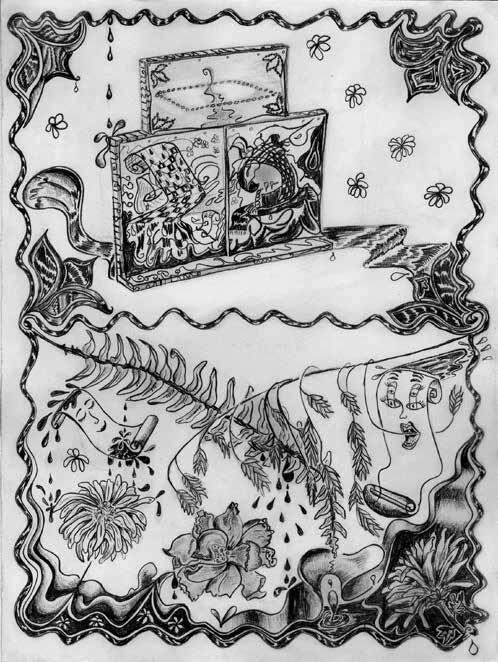 (clockwise from top left)
1. William Sieruta, Rainbow Trout , oil on panel, 25 x 22 in.
2. Scott Reeder, Bread & Butter (Hot Tub w/ Sunset), 2022, oil on canvas, 24 x 36 in., Courtesy of CANADA gallery NYC
3. Rachel Niffenegger, Wraith 4 , 2021, dye sublimation on brushed aluminum chroma luxe panel, frame mount, 36 x 36 in.
(clockwise from top left)
1. William Sieruta, Rainbow Trout , oil on panel, 25 x 22 in.
2. Scott Reeder, Bread & Butter (Hot Tub w/ Sunset), 2022, oil on canvas, 24 x 36 in., Courtesy of CANADA gallery NYC
3. Rachel Niffenegger, Wraith 4 , 2021, dye sublimation on brushed aluminum chroma luxe panel, frame mount, 36 x 36 in.
14 2023 SUMMER COURSE CATALOG
4. Ruby T, Vision for altar for getting slammed so hard by a wave, 2020, graphite on paper, 9 x 12 in.
(clockwise from top right)




 1. Laurel Sparks, Mercury, 2020, poured gesso, waterbased paint, ash, paper pulp, glitter, holes, collage, woven canvas strips, 28 x 28 in.
2. Joseph Mario Romano, Empty Bird Feeder 3, 2017, watercolor, 10 x 10 in.
3. Josh Dihle, Vision, 2020, rocks, fossils, and oil on canvas, 18 x 14 in.
4. Carrie Gundersdorf, Ivory Cone , 2022, blue-violet-grey, colored pencil and watercolor on paper, 24 x 21 in.
1. Laurel Sparks, Mercury, 2020, poured gesso, waterbased paint, ash, paper pulp, glitter, holes, collage, woven canvas strips, 28 x 28 in.
2. Joseph Mario Romano, Empty Bird Feeder 3, 2017, watercolor, 10 x 10 in.
3. Josh Dihle, Vision, 2020, rocks, fossils, and oil on canvas, 18 x 14 in.
4. Carrie Gundersdorf, Ivory Cone , 2022, blue-violet-grey, colored pencil and watercolor on paper, 24 x 21 in.
15
5. Turtel Onli, Koko Arte Textile, circa 2020, textile pigments on cotton, 50 x 50 in.
CHOP SHOP: GUIDED TRANSFORMATIONS
with Jessica Gatlin & Brandon J. Donahue
PRINT | 664 001 | 3 CREDITS
$150 LAB FEE | MAY 28 - JUNE 10
Class as collage, mixtape, chop shop - a place where vehicles are dismantled and distributed. In this course, students are encouraged to explore a variety of media through both individual and collaborative prompts. Group discussions will be had on authorship, appropriation, the collective, the individual, and transformation. Students will engage with techniques and media such as airbrush, assemblage, performance, and print to repair, examine, and transform objects and practices. Readings will include The Aesthetics and Ethics of Copying from Darren Hudson Hicks and select works by bell hooks. Assignments will include Communicative Practice Scoring in which participants will be challenged as maker, facilitator, audience, and interpreter. The class will culminate in a group project guided by our discussions and is adaptable according to the group’s skills and interests.
RISO-RELATIONS & BOOKISH BEHAVIORS
with
Madeleine Aguilar
& bex ya yolk
PRINT | 668 001 | 3 CREDITS
$150 LAB FEE | JUNE 11 - 24
This course is an introduction to the RISOgraph as a tool for high volume printing, editioned objects, and bookmaking to produce publications in printed bookish form. Students will experiment with a range of binding, printing, and sculptural tools to create publications while learning a variety of book structures and binding techniques. Equipment and praxis include but are not limited to: the RISOgraph printer, screen printing, xerox copier, comb binder, Epson scanner, laminator, spiral bound machine, and hand bookbinding tools.
Daily in-class technical demonstrations in tandem with lectures on independent presses, zine makers, works by artists and publishers that utilize the RISO as both an economic and artistic tool, and prominent book artists’ will all be explored. The class will culminate in the production of a publication for the Ox-Bow Artists’ book and Zine Library (est. 2023). Each student will donate at
least one book from their edition(s) to the collection. This gesture in fostering community by means of leaving ephemera and art objects for future artists to engage with, is the very core of what arts publishing can be.
QUEER METHODS IN GLASS & PRINT
with H Schenck & Liesl Schubel
PRINT & SCULPTURE | 669 001 | 3 CREDITS $350 LAB FEE | JULY 10 - 22
This cross-disciplinary course will be hosted in both the print studio and glassblowing studio and encourages experimental making processes that blur image, language, and sculpture. Taking inspiration from printmaking’s origins in published activism, and glassblowing’s inherent denial of binaries as an amorphous solid, students will self-innovate the basic principles of each process, dissolving the boundary between media, to create a collection of objects and images with glass. Students will learn the process of vitreography, a technique for fixing an image within a sheet of float glass to create an impression on paper. In the glass studio, foundational glassblowing skills will lead to more complex shapes, including rondels and cylinders for custom flat glass, and more flowing, unusual forms. We will consider artists who generate language and instigate play, including Anna Mlasowsky, Victoria Ahmadizadeh Melendez, and Elizabeth Atterbury, while reading “Daybook” by Anne Truit and “Learning to Love You More” by Miranda July. We will also host/discuss screenings about Jes Fan and Amos Paul Kennedy Jr. To maximize cross-studio collaboration, students enrolled in this course will alternate back and forth between the printmaking and glass spaces. In addition to vitreography exercises, assignments will include pyrographic drawings and glass capsules and the course will culminate with salon-style installations of created and found objects.
DECONSTRUCTING ART & DESIGN IN THE LIVED ENVIRONMENT
with Nia Easley & Ashley M. Freeby
PRINT | 667 001 | 1.5 CREDITS
$100 LAB FEE | JULY 23 - 29
In our environment, how do we use our bodies to create design? In this course
students will be challenged to consider the overlap between the skills we use to create art and those designated as design. We will review the basic concepts of art and design, comparing the language that is used in each discipline to define those concepts such as: audience, aesthetics, composition, etc. We will think through ideas around Gesamtkunstwerk - or “total design” - as seen in the ideologies behind art nouveau, de stijl, bauhaus and others. We will spend time observing the campus, actively looking at the designed elements around us like the iconic Ox-Bow burials and assortment of hand-painted signs scattered around campus. Then we will use the Ox-Bow campus to supply the raw materials which we will bring back into the studio to create 2-D work using slow processes (i.e., collagraph, monotype, collage, screenprinting, cyanotype, anthotype, etc.) The class will culminate in addressing a design issue on the grounds as a group project without the use of digital technology.
LITHOGRAPHY: STONE & PHOTOLITHOGRAPHY with
Danny Miller & Kristina Paabus
PRINT | 637 001 | 3 CREDITS
$200 LAB FEE
JULY 30 - AUGUST 12
This fast-paced course is designed for both beginners and advanced artists, and will be offered in a two-week sequence. Week one focuses on traditional methods with stone lithography, and week two introduces students to photomechanical lithography using both hand-drawn and digital processes. Students are encouraged to investigate personal directions in their work as they explore lithographic possibilities through editions and unique variants. Emphasis will be placed on both conceptual and technical development, and additional demonstrations will be added based on the specific interests and needs of the participants. Class consists of demonstrations, presentations, work time, discussions, and critiques. Historical and contemporary lithographic examples will be presented in order to clarify the relationships between idea, context, material, and process.
16 FOR FACULTY BIOS TURN TO PAGE 32 2023 SUMMER COURSE CATALOG
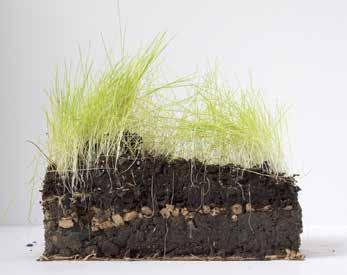
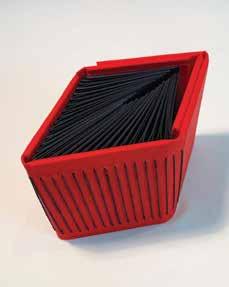
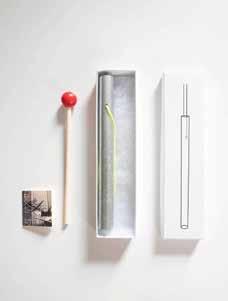




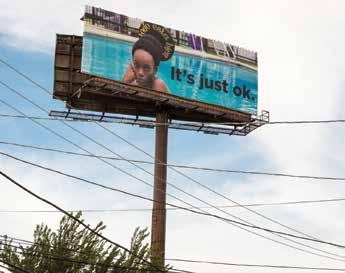 (left to right) 1. Jessica Gatlin, Abode: Contemporary Art & Craft Exhibition Space, Tithes & Offerings , 2021, artworks by Abigail Lucien, Sam Dunson, Anna Wehrwein, and TaO, size variable; 2. Brandon J. Donahue, Basketball Bloom (NCAA Mask), 2017, searched for and found basketballs, shoestrings, 3 x 4 x 2 ft. ; 3. Madeleine Aguilar, door bell, 2021, steel pipe, nylon mason line, and wooden mallet, 8x 2 1/2 x 1 in.; 4. bex ya yolk, O rigami Diamond Book , 2020, Neenah 80 lbs cardstock paper, book cloth, book board, linen 18/3 thread, PVA, Velcro, 16 3/4 x 3 in. (extended); 5. Danny Miller, Zombie Satellite #1, 2022 , crayon, acrylic and graphite on paper, 22 x 18 in.; 6. Kristina Paabus, Impossible Too, 2021, wood lithography, aquatint, and screenprint, 24 x 20 in.;
(left to right) 1. Jessica Gatlin, Abode: Contemporary Art & Craft Exhibition Space, Tithes & Offerings , 2021, artworks by Abigail Lucien, Sam Dunson, Anna Wehrwein, and TaO, size variable; 2. Brandon J. Donahue, Basketball Bloom (NCAA Mask), 2017, searched for and found basketballs, shoestrings, 3 x 4 x 2 ft. ; 3. Madeleine Aguilar, door bell, 2021, steel pipe, nylon mason line, and wooden mallet, 8x 2 1/2 x 1 in.; 4. bex ya yolk, O rigami Diamond Book , 2020, Neenah 80 lbs cardstock paper, book cloth, book board, linen 18/3 thread, PVA, Velcro, 16 3/4 x 3 in. (extended); 5. Danny Miller, Zombie Satellite #1, 2022 , crayon, acrylic and graphite on paper, 22 x 18 in.; 6. Kristina Paabus, Impossible Too, 2021, wood lithography, aquatint, and screenprint, 24 x 20 in.;
17
7. Nia Easley, It's Just OK , 2019, billboard, printed ephemera, walking tour, website, photograph by Milo Bosh; 8. Ashley M. Freeby, Segment 091 dedicated to LaTanya Haggerty who we lost on June 4, 1999 in Chicago, IL at age 26
DEADPAN: STEEL REALISM
with Chris Bradley
SCULPTURE | 671 001 | 3 CREDITS $200 LAB FEE | MAY 28 - JUNE 10
When representation in steel is achieved the result can often be both playful and hollow. In this process-based intensive, students will consider how much visual and physical information is necessary in the pursuit of realism and experiment with the formal limits of steel. Inspiration can be drawn from a common object, local or organic materials, and/or fictive designs to explore the whimsy of trompe l’oeil. This class is open to participants of all shop experience levels. Demonstrations on sheet cutting, creating negative space through rod work, scale exercises, and surface applications both traditional and unconventional will inform the student’s self-directed work. Students will be expected to complete at least one sculpture and are encouraged to consider its in-situ presentation at Ox-Bow during a final group critique.
THE WORLD IS ONE. THE HUMAN IS TWO: DECONSTRUCTING AND RECONSTRUCTING OBJECTS
with John Preus
SCULPTURE | 684 001 | 1.5 CREDITS
$50 LAB FEE | JUNE 11 - 17
This course will challenge students to work across two hand-made designed objects, one chosen and one randomly procured, to create a third sculpture which creatively considers form, function, destruction, and collaboration. Students will provide the items, which must be made by a human and no bigger than 3 feet on any side, and participate in an object swap to secure their second subject. Demonstrations including chop saw, band saw, jig saw, and other basic building tool usage will introduce students to a variety of processes they can utilize in constructing/ deconstructing their object. Throughout the creation process we will discuss the object as sacrament, fetish, scapegoat, and as matter of hermeneutics. We will look at the work of contemporary artists such as Brian Jungen, Edra Soto, Amanda Williams, Theaster Gates, Doris Salcedo, and others. Because of the short length of time we have together, some short limited readings will be assigned, but a more extensive list of resources and texts will
be made available. Susan Sontag, Laura Kipnis Against Love, Joan Didion on Desire, Peter Rollins on the Lacanian subject and the church that believes in nothing. Colby Dickinson on the Sacrament and the Fetish object, Rene Girard on the scapegoat and mimetic desire. Students should be prepared for a robust collaborative experience as this course will dedicate significant time to the ritual and performance of the object exchange, so as to set the stage for considering the relationship between forms. This course will culminate in a final presentation of sculptures thoughtfully installed indoors or out.
SPECULATIVE TOOLS
with Barb Smith
SCULPTURE | 683 001 | 1.5 CREDITS
$50 LAB FEE | JUNE 18 - 24
In this course we will consider the relationship between tool and art and participate in exercises which cause the categories of subject and support to blur. Students will create a unique tool to both gather information from the Ox-Bow landscape and assist in the creation of their multi-media work. Demonstrations that will assist the student in building their tool and work will include simple and non-traditional mold making, minorwoodworking, metal work including basic welding and armature making, found object assemblage, and textile techniques including weaving. We will consider the work of Ana Bidart and William Lamson, and readings and screenings may include Enzo Mari’s Sixty Paperweights, texts on colloquial architecture related to sites such as the Coral Castle Museum, and archeological methodologies for collection and cataloging. The tools can be elements of measurement or assist in creating a specific and unique mark. Drafting assignments will ask the students to consider the function of this tool within their project goals. This course will culminate in a presentation of tools and artworks.
INFLATING STEEL: THERMO-PNEUMATICHYPER-FORMING
with
Jessee Rose Crane
SCULPTURE | 674 001 | 3 CREDITS $225
LAB FEE | JULY 10 - 22
In this class, students will be led through the wild process of inflating welded steel structures. Sheet steel armatures will
be welded, put into a forge and heated until bright orange, then inflated with compressed air. Students will work in an improvisatory mode, rapidly iterating many pieces over the session. Studio work will be augmented by lectures, discussions, and critique that support discovery and play within the studio and this largely untapped process. We will look at the work of American blacksmith Elizabeth Brim and Polish designer Oskar Zieta and pull inspiration from the polygonal geometries of indie video game design as well as the palette of Brutalist architecture. The culminating assignment in this course will invite students to design and create a steel inflatable that will be safely installed on the surface of Ox-Bow’s Lagoon. Thoughtfulness, intent, and context will be emphasized. This class is beginner-friendly, and will serve as an introduction to metal fabrication and finishing.
CONTAINER TECHNOLOGIES
with Lesley
Jackson
SCULPTURE | 677 001 | 3 CREDITS $200 LAB FEE | JULY 30 - AUGUST 12
This course explores the fundamentals of metalworking through the conceptual lens of holding, containment, and display. Projects will delve into the history of handmade containers - hooks, hangers, boxes, lockets, vessels, reliquaires, pedestals, frames - as points of entry into new objects, from the functional to the absurd. We would explore the container as a tool for holding and as a means of veneration - creating spaces for things to be seen, held, interacted with, and cared for. Some craft traditions we make look to include the hand-forged steel hook, Shaker box-making, and medieval reliquaries and their corresponding rituals. Readings may include “Container Technologies” by Zoë Sophia, “Things” by Bill Brown, and “The Carrier Bag Theory of Fiction” by Ursula Le Guin. Using the starting point of simple hook making, we will build knowledge and momentum toward individual projects which may focus on container archetypes; the box, something that protects and the stand, something that displays. Both sheet metal fabrications and bar, rod, and behind techniques would be demonstrated in service of these assignments. This class will culminate in a group work share of each student’s final project.
18 FOR FACULTY BIOS TURN TO PAGE 32 2023 SUMMER COURSE CATALOG
MULTI LEVEL FOUNDRY with Brent Harris
SCULPTURE | 660 001 | 3 CREDITS

$350
LAB FEE | AUGUST 13 - 26
In this multilevel metal casting course, students will learn the fundamentals of pattern generation, simple and multipart mold making techniques with sodium silicate bonded sand, casting with bronze, aluminum, and finishing and patination techniques for their castings. Explorations will be informed by the materiality of molten metal and molding processes, the history and technologies of metal casting, and discussion of cast metal sculpture in contemporary art. In the spirit of there is no “I” in foundry, teamwork and safe foundry practices form the foundation of the course. Students will be encouraged to experiment and respond to the natural environment with patterns made at Ox-Bow in an open-air sculpture studio.
Barb Smith, Object (about eyes), 2018, hydrocal, paraffin wax, expansion cement, Aqua-Resin, two months of making strata, 4 x 6 x 3 in.

John Preus, Stoop #5, 2020, found fabrics collected from Chicago alleyways and thrift stores, 24 x 40 x 28 in.
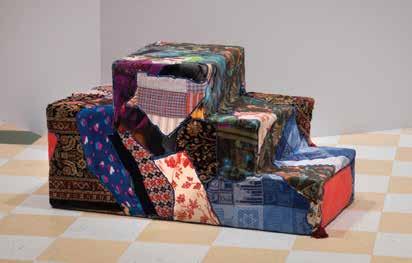

Brent Harris, Untitled Doe, 2021, ceramics and acrylic, 17 in. long


Chris
2016,
(center)
(left)
Bradley, Chip,
painted cast bronze, 1 x 2 1/2 x 2 1/2 in.
Jessee Rose Crane, Doozy, 2017, mixed media, found objects, steel, wood, bronze, magnifying lenses, 8 x 3 x 9 ft.
(bottom right)
Lesley Jackson, Baudelaire's Key Holder, 2022, blackened steel, mirror, found candlestick, Douglas fir, ribbon, rock. 22 x 6 x 30 in.
19
ARTIST COMMUNITIES: CREATIVITY, COOPERATION, AND PLACE


with
Annalise Flynn & Fathye Levine
ART HIST | 626 001 | 3 CREDITS
MAY 28 - JUNE 10
How can artist communities nurture creative lifestyles and communal healing? In this highly collaborative class, we will study the development of artist communities, including Ox-Bow School of Art, as sites of experimentation and refuge, and discuss how these places serve artists and their communities. Readings will include 1977 Craft Horizons essay “Black Mountain College: A Golden Seed” by M.C. Richards, the 1974 Archives of American Art oral history interview with Elsa E. Ulbricht and Piney Woods, and Atlas vol. 1 & 2. By focusing on select Ox-Bow alumni, including Elsa Ulbricht, Roger Brown, and Theaster Gates, we will learn more about the shifting cultural landscape of the school and the ongoing development of artistcreated places. We will discuss artist colony frameworks from craft schools that have fostered generations of creative community and tradition to contemporary creative places that are forward-looking sites of care, inclusion, and liberation. With daily writing assignments which examine historic artist-created places through a critical lens, the course will culminate in a final project focused on student-invented community models that envision working toward a more cooperative and connected future.
PAPERMAKING STUDIO
with
Andrea Peterson
PAPER | 604 001 | 3 CREDITS
$150 LAB FEE | JUNE 11 - 24
Paper as an art medium is exciting and elusive. Paper pulp can be transformed into sculptural works, drawings with pulp and unusual surface textures. It can allude to skin, metal, rock or something quite totally different. Explore all of these possibilities. Stretch your artistic and technical skills to create unusual works of art.
1. Chris Edwards, Oxbow Quilt, 2022 (opposite page)
1. Padma Rajendran, Along the way, 2019, dye on silk with stitching, dimensions varied
20 2023 SUMMER COURSE CATALOG HAI-WEN LIN, 2022 LEROY NEIMAN FELLOW
2. Joann Quiñones, Toussaint of Ward Avenue, Osnaburg, 2019, linen, coffee-stained muslin, Dutch-wax prints, digitally printed organza, ruff, indigo dyed cotton, porcelain, terra cotta, gilding, pearls, 84 x 40 x 40 in.
ATTITUDES BECOME FORM
with
Christalena Hughmanick
PERFORMANCE | 607 001
1.5 CREDITS | $50 LAB FEE
JUNE 25 - JULY 1
The studio course looks at working methods within the field of performance art to facilitate collective effort as a format for production and presentation. The relationship of produced sculptural apparatuses to the maker’s body will be explored as a form of support for generating physical action. Installed environments and extensions of the artist will be used as props to propel action. Participants will engage in daily performance exercises with found materials and basic construction methods related to fabric and paper will be demonstrated. This course combines Postminimalism and the Process Art Movement with Performance Art and its roots in Dada. It uses the 1969 exhibition Live In Your Head: When Attitudes Become Form, curated by Herald Szeemann as a primary example of the course topics. Works shown will also include Oskar Schlemmer’s Triadic Ballet (1922), Bruce Nauman’s studio experiments such as Dance or Walk on the Perimeter of a Square (1967), Allora & Calzadilla’s Track & Field (2011) and Alexandra Bachzetsis’ The Stages of Staging (2012) among others. We will read Exhaustion and Exuberance: Ways to Defy the Pressure to Perform
by Jan Verwoert. Participants will construct sculptures or wearable works to perform with as the final work. Collaboration with others in the class is encouraged but not required.
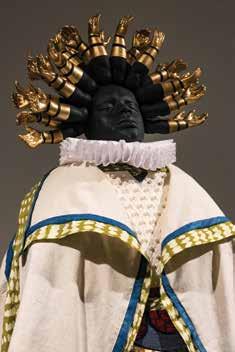
WET PLATE PHOTOGRAPHY with Jaclyn Silverman
PHOTO | 613 001 | 1.5 CREDITS $125 LAB FEE | JUNE 25 - JULY 1
Using the historic and time-honored wet-plate collodion process, students will move between the studio, the community, and the natural environment to create glass plate images and photographic objects. We will explore the fundamentals of large format view camera photography while using individual mobile darkrooms for plate processing and production. This course considers the technical information, historical use, and advancement of photographic technology in comparison with contemporary conceptual use by late-20th-century and current 21st-century artists such as Helen Maureen Cooper, Joni Sternbach, and Sally Mann. Readings available for reference include Basic Collodion Technique: Ambrotype and Tintype, by Mark Osterman and France Scully Osterman, and Chemical Pictures: The Wet Plate Collodion Book, by Quinn B. Jacobson. Students will work independently, progressing from
tintype positives to glass negatives and ambrotype objects. Subjects can include the still life, portraiture, installation for performance, or natural documentation of the environment. Daily evaluations and cross-classroom conversation will address technical and conceptual issues, and question historical and contemporary uses. The final product will include a suite of quarter glass plates in the student’s own style, driven by individual concepts or ideas.
EXPERIMENTAL PATTERNING: METHODS IN TEXTILE PRINTING
with Padma Rajendran
FIBER | 622 001 | 1.5 CREDITS
$100 LAB FEE | JUNE 25 - JULY 1
Decorating textile is a global tradition that continues to inspire artistic, commercial, and domestic spaces. Discover the techniques within fabric printing and explore how to transform textile. In this introductory course, students will learn the basics of screen printing and block printing onto fabric. Students create and print their own designs using printmaking inks and Procion dye. We will enhance our fabrics with reflective foil printing and dye baths to create patterns that sit on the surface and invent images that become a part of the fiber. Students are welcome to bring their own
light colored fabrics -cotton, linen, silk. Students will screen print with water-based inks on fabric and utilize Procion dyes to experiment with block printing. Students will continue transforming their fabric with resist and dye techniques. Through daily demonstrations and active studio time, students will experiment with repeat patterns and printing singular images. As a class, will explore these different printing approaches as tools for students to create print work, painting surfaces, decorative objects, or installation.
NATURAL DYES & WEARABLE SCULPTURE

with
Joann Quiñones
FIBER | 625 001 | 3 CREDITS
$150 LAB FEE | JULY 10 - 22
Prior to 1856, all dyes used on textiles came from natural sources. In this course we will explore multiple ways of adding color to cloth, with particular attention paid to patterning created through resist methods such as pastes, waxes, stitching, and binding. As a class we will use cotton and incorporate methods such as printing with mordants. We will also explore the metaphorical components of color and the use of fiber as an act of resistance and self-expression. In this course we will read excerpts from Maggie Nelson’s lyric essay,
21 FOR FACULTY BIOS TURN TO PAGE 32
Bluets as our meditation on color. The Art and Science of Natural Dyes by Joy Boutrup and Catharine Ellis will provide us technical guidance, and by examining the work of artists such as Pia Camil and Nick Cave we will draw inspiration for our final wearable sculpture project. Screenings will include, “Conversations with Jim Arendt”. Assignments will include a Kanga inspired textile to showcase the use of patterning and layering of natural dyes and a wearable sculpture collaborative project.
PAPERMAKING STUDIO
with
Ciel Rodriguez
PAPER 604 001 | 1.5 CREDITS
$150 LAB FEE | JULY 23-29
Paper as an art medium is exciting and elusive. Paper pulp can be transformed into sculptural works, drawings with pulp and unusual surface textures. It can allude to skin, metal, rock or something quite totally different. Explore all of these possibilities. Stretch your artistic and technical skills to create unusual works of art.
GEOGRAPHY OF THE VOID
with
Devin T. Mays
PERFORMANCE | 608 001
1.5 CREDITS | $100 LAB FEE
JULY 23 - 29
During this course we will discuss matters of space and place. Space is defined as immaterial, the void between things, and place as material, the geography of the thing or the location of the immaterial. As a group we will test this ideology and prescribe characteristics of existence, a continuity that infers being, via the artist’s body and incorporate performance and moving image to complicate, frustrate, and further that understanding. Studio prompts will be used as formal exercises to materialize concepts. Screenings,
writing, and readings will be used for reflection. The woods will be our place to wander. For examples on position, reposition, invention, and intervention we will consider the works of The Mono-ha movement, The Association for Creative Musicians (AACM), Catherine Sullivan, Hollis Frampton, Adrian Piper, and Don and Moki Cherry. Readings will include Francis Alÿs’ “As Long as I’m Walking”, William Greaves’ “Filmmaking as Mission” by William Greaves, and “Wandering: Philosophical Performances of Racial and Sexual Freedom”. We will screen Barbara McCollough’s “Freeway Fetishes and Shopping Bag Spirits”, William Greaves’ “Symbiopsychotaxiplasm: Take One”, David Hammons’ “Phat Free”, and John Cage & Rashaan Roland Kirk’s “Sound??”. Students will participate in daily performative and contemplative exercises that will culminate in the production of one formal, modest or monumental gesture within the Ox-Bow geography by creating a 3-minute performance or 3-minute moving image.
SOFT COMPOSITIONS
possible with traditional stitch and applique techniques of quilt-making, this highly collaborative and social course will be inspired by the works of Rosie Lee Tompkins, the Gees Bend Quilters, Claes Oldenberg, RuPaul, David Byrne, and Lee Bowery. Screenings may include True Stories (1986), Common Threads: Stories from the Quilt (1989), and readings may include “Knitting, Weaving, Embroidery, and Quilting as Subversive Aesthetic Strategies: On Feminist Interventions in Art, Fashion, and Philosophy” (Michna 2020). Students will conceive and construct original fiber works in response to assignments that focus on the expressive, personal, and comical possibilities of these materials. Assignments will include completing piecing, construction, binding, and quilting of a full personal quilt project, collaborating on group textiles, even with artists in other classes, and students will make a wearable item for Ox-Bow’s Friday Night Costume Party. The course will culminate in a group quilt show installed in the landscape.
PROVISIONAL SPACE
with Charlie Vinz & B. Ingrid Olson
and nomadic design. We will look for patterns, impressions, and markings that give way to our presence, preferences, and patterns of living. The writings and research of Bernard Rudofsky (The Prodigious Builders), the work of experimental architects and writers Shusaku
Arakawa and Madeline Gins (The Saddest Thing Is That I Have Had To Use Words), the philosophical investigations of Elizabeth Grosz ( Architecture from the Outside), and texts by architectural historian Beatriz Colomina (Sexuality and Space), will all be referenced in our explorations, readings, and discussions. Wavelength by Michael Snow is a potential screening to be included Students will develop a second self for which to create a narrative and representative exterior space using only materials gathered from a defined radius.
BIRD SCIENCE: AN INTRODUCTORY SURVEY
with Dr. Dianne Jedlicka
SCIENCE | 604 001 | 3 CREDITS
AUGUST 13 - 26
with
Chris Edwards & Lauren Gregory
FIBER | 627 001 | 3 CREDITS | $50
LAB FEE | JULY 30 - AUGUST 12
This course celebrates handicraft and invites students into the sewing circle in service of solving compositional problems with the language of quilting. Serving students at all levels of experience, participants will learn traditional, nontraditional, machine, and hand-sewing techniques to produce soft objects including quilts, banners, windsocks, dolls, and installations. Demonstrations on mapping 2D and 3D images, piecing, applique, dyeing, and additive image making will encourage the exploration of the alternative and whimsical sensibilities in soft sculpture. Platforming the loose and improvisational mark-making
SCULPTURE | 678 001 | 3 CREDITS
$100 LAB FEE | AUGUST 13 - 26
This class will explore our various efforts to define and create spaces outside of traditional structures that we otherwise use to house us and our activities. Can we unbuild our environment to better understand these spaces? We will think about the physicality of a provisional space, and what sorts of impressions our bodies leave or imply when we’re not physically there. We will also sift through the remnants and detritus of our contemporary built environment to explore how it can be reinterpreted as a series of inexhaustible materials along a lifecycle continuum. This class will look at the architecture of non-humans, as well as examples of ephemeral, temporary, responsive
Ox-Bow provides a wonderful opportunity to observe many species of native birds in various habitats. This class will utilize the forest, meadow, dune, and lake in the vicinity by learning to identify local species followed by conducting observational research on select species. Worldwide distribution of the different bird families will then be looked at. The physics of flight, bird anatomy and physiology will be discussed. Lectures regarding egg laying, ecological and evolutionary adaptations and environmental influences on synchronization of egg hatching, food availability, predator/ prey relationships, and migrations will be augmented by field trips to local zoos and
One identification test and two original written bird lab research papers will be required.
museums.
22 FOR FACULTY BIOS TURN TO PAGE 32 2023 SUMMER COURSE CATALOG
(opposite page from top left) 1. Jaclyn Silverman, Summer School, 2022, wet plate collodion ambrotype, 4 x 5 in.; 2. Devin T. Mays, Line, Weight, 2021, concrete and metal; 3. Dr. Dianne Jedlicka, Examples of books for Bird Science: An Introductory Survey; 4. Christalena Hughmanick, Consideration of a Volcanic Nature Sculpture, 2020, found rocks, ochre, flour, water, performance; 5. Fathye Levine, research in the Charlotte Russell Partridge and Miriam Frink Papers 1862-1980 , housed at the University of Wisconsin-Milwaukee Libraries’ Archives Department, 2021; 6. Lauren Gregory, Cave Laur, 2022, oil paint on fake fur, 23 x 16 in.; 7. Charlie Vinz, Buddy Shop interior, 2021, salvaged OSB & lumber, marmoleum, felt, homasote, 1200sf ; 8. Andrea Peterson, Osmosis, 2019, multimedia, 9 x 12 in.; 9. B. Ingrid Olson, installation view of Proto Coda Index (2016-2022) in the exhibition History Mother (2022) at the Carpenter Center for the Visual Arts at Harvard University, Cambridge; 10. Ciel Rodriguez, i hope we can be birds together in the next life…, 2021, pigmented abaca, lilies, tea leaves, cyanotype, thread


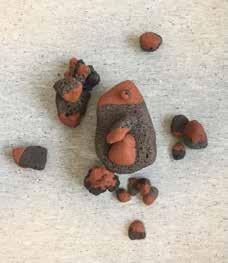

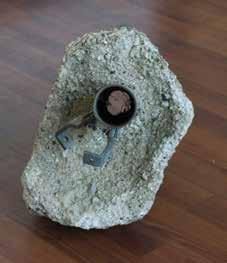

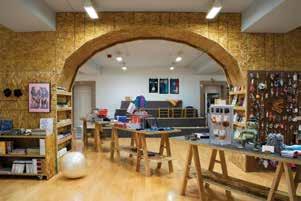



23 FOR FACULTY BIOS TURN TO PAGE 32
ONLINE COURSES
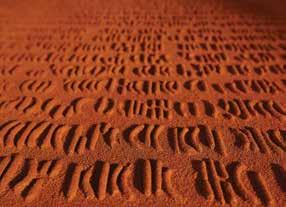
WANDERING SPIRITS
with
Joseph & Sarah Belknap
PHOTO | 615 001 | 3 CREDITS
JUNE 5 - 17 | 10:00 AM - 12:30 PM CST
What does it mean to make an image?
In this course we will make images and photographs using the Earth’s Sun in collaboration with photographic techniques that emerged in the 1800s and continue to be used in contemporary art. We will play with digital photography, anthotypes, cyanotypes, chlorophyll prints, and other alternative photographic techniques. We will utilize photography, drawing, painting, and collage to make images with depth, vibrancy, and wildness. Our images will be experienced through virtual worlds and platforms as well as physical spaces of the home, communities and other locations through posting, installing, inserting, publishing and other possible ways where images can be transmitted. The acceleration of image production has transformed our understanding of ourselves by folding the horizon in on itself. We will look into phenomenological studies of being while making images that examine our contemporary conditions of the power within our lives that these images can serve, deconstruct and reinvent. From social justice, deep fakes, intimacy, ecologythe political impact of images shape our existence. While we look at contemporary and historical image making we will look at ways of seeing. Artists will include Anna Atkins, Kiki Smith, Candice Lin, Zadie Xa, and Dario Robleto. Readings and screenings for this course will include Rebecca Solnit, Susan Sontag, Jean Painlevé, Sara Ahmed, and Hito Steyerl. Assignments will invite students to respond to the reading and viewing of Hito Steryerl’s work on How not to Seen and create a series of images using the Cyanotype Process. We will also consider the perspective points of the viewer and the processes of concealment that make this object or subject hidden in plain sight.
MATERIAL CODE
with Samantha Bittman
FIBER 626 / PAINTING 603 001 | 3 CREDITS
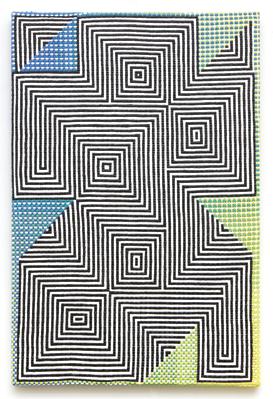
JUNE 8 - 21 | 10 AM - 12:30 PM CST
In this course, students will explore how the weave draft technique, often utilized
by weavers for the loom, can generate patterned binary code which can then be translated into textile, painting, sound, and many other media. Focusing on the communicative capabilities of their chosen material, students will draft and manipulate algorithmic pattern generators to produce endless patterns of 1’s and 0’s. Works made by artists including Anni Albers, Xylor Jane, Beryl Korot, and kg will lead us into conversations around the origins of weaving, the loom, computers, and algorithmic art making. Discussion will be supplemented by Bhakti Ziek’s “The Woven Pixel”, Beverly Gordon’s “Cloth as Communication”, and “Chris Ofili: Weaving Magic”. Assignments will include drafting a “Sample Blanket” with graph paper, colored pencil, and other flat materials and, while contemplating how material choice makes meaning, final pieces of any media that utilize the code will be shared amongst the group.
NATURAL PIGMENTS: PROCESS, MATERIAL, & HISTORY
with Gunjan Kumar
PAINTING | 676 001 | 3 CREDITS

$150 LAB FEE | JUNE 22 - JULY 5 10AM - 12:30PM CST
Taking inspiration from ancient methods of image making this course will introduce students to the process of working with organic and inorganic natural pigments. These pigments have a distinct aura that when mixed with organic binders, in varying densities, can be used to achieve ethereal surfaces. Students will receive a kit to be able to mix their own media and will learn to work with pigments including calcium carbonate, powdered clays, oxides, ochers, and pine soot. The course will include on important sites of prehistoric cave painting around the world and derivative processes and materials in related schools of art. In addition to media mixing, color theory discussion, and the completion of two-dimensional self-directed artworks, assignments will guide students through various experiments in paper sizing and mounting. Students will be introduced to techniques of foraging and harvesting earth pigments from natural surroundings and this course will culminate in a presentation of completed work.
24 FOR FACULTY BIOS TURN TO PAGE 32 2023 SUMMER COURSE CATALOG
1. Sarah and Joseph Belknap, Yikes, 2020, 10 x 10 in.; 2. Samantha Bittman, Untitled, 2020, acrylic on hand-woven textile, 30 x 20 in.; 3. Gunjan Kumar, What Remains 1 (Detail), 2021, clay on handwoven raw (kala) cotton
THE LEROY NEIMAN FELLOWSHIP PROGRAM
Each summer, Ox-Bow offers fellowship students from competitive schools all over the nation a fully funded opportunity to focus on their work, meet with renowned artists, and grow as members of this unique community. The fellows experience the entire summer session and live on campus for 13 weeks where in addition to providing support labor to an arts non-profit, they will participate in all areas of campus life. By working closely with staff, fellows develop relationships with others who have also made artmaking their lives.
Fellows are selected based on the merit of their work, their commitment to making inspired and innovative art, and their stated growth potential at Ox-Bow. The fellowship program is a once-in-a-lifetime opportunity to participate within an engaging artist-run community.
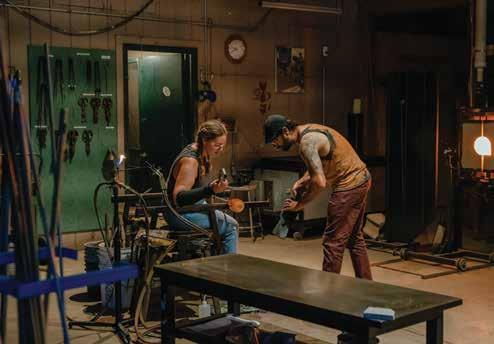
Ox-Bow works with partner schools to bring in fellows from across the country. Ox-Bow’s partner schools include Cooper Union, Cranbrook Academy of Art, Grand Valley State University, Kansas City Art Institute, Pratt Institute, Rhode Island School of Design, the School of the Art Institute of Chicago, the University of Texas at Austin, and Tyler School of Art. Students from these schools can apply through their school or apply directly to Ox-Bow for the open spots available to students from any school.
The 2023 Fellowship dates are May 25 - August 28
202 2 FELLOWSHIP STUDENTS
Aidan Lapp Pratt Institute
Zena Segre Cranbrook Academy of Art
Aleah Washington Kansas City Art Institute
Yeji Kim Cooper Union
Summer Moore Tyler School of Art and Architecture
Frank Vega School of the Art Institute of Chicago
Blake Matthews Grand Valley State University
Leah Shirley University of Texas at Austin
FELLOWSHIP RECIPIENTS RECEIVE:
• A studio space with 24 hour access
• Stipend for on campus labor
• Housing and 3 meals per day
• Weekly studio visits with visiting artists
• Opportunity to exhibit their work
• Opportunity to TA a class
WHO CAN APPLY FOR A FELLOWSHIP?
• Students from any school
• Ox-Bow offers fellowships to undergraduate and graduate students from any degree-seeking institution
• Ox-Bow offers 2 fellowships to undergraduate and graduate students from the School of the Art Institute of Chicago
• Students chosen by Partner Schools.
ELIGIBILITY
Applicants must:
• Be undergraduate students in the junior/ senior year or MFA students
• Have a graduation date of December 2022 or later
• Be at least 21 years old at the start of the fellowship
• Have the ability to work in the United States or have a work visa
Scott Vanderveen Rhode Island School of Design
Abbey Muza Tyler School of Art and Architecture
Sequoia WilliamsValenzuela College of DuPage
Hai-Wen Lin School of the Art Institute of Chicago
Learn more about the fellowship by scanning the QR Code 25 JAMIE KELTER DAVIS
CERAMICS
SESSION ONE
May 28 - June 10 (2 weeks)
Flora, Fauna, Figure, & Narrative
Salvador Jiménez Flores & Casey Weldon
GLASS
PAINTING
Paint Makerspace
Laurel Sparks
SESSION TWO
June 11 - 24 (2 weeks)
Woodfire: Ancient Methods & Contemporary Conversations
Henry Crissman & Virginia Torrence
Glassblowing
Will Hutchinson & Yashodhar Reddy
Paint Makerspace
Rachel Eulena Williams
PRINTMAKING
Chop Shop: Guided Transformations
Brandon Donahue & Jessica Gatlin
Deadpan: Steel Realism
SCULPTURE + METALS
Chris Bradley
Riso-Relations & Bookish Behaviors
Madeleine Aguilar & bex ya yolk
The World is One.
The Human is Two: Deconstructing and Reconstructing Objects
John Preus
Speculative Tools
Barb Smith
SPECIAL TOPICS
Artist Communities: Creativity, Cooperation, & Place
Annalise Flynn & Faythe Levine
Ritual Embrace
Ruby T
Papermaking Studio
Andrea Peterson
SESSION THREE
June 25 -
July 1 (1 week)
SESSION FOUR
July 10 - 22 (2 weeks)
The Ancient Future: Clay & Sound
Israel Davis & Douglas R. Ewart
Stripes: Introduction to Cane Making
Matt Urban
Flameworking: Finding Form in Translation
Carmen Lozar
Drawing Place in Watercolor & Gouache
Carrie Gundersdorf
Experimental Patterning: Methods in Textile Printing
Padma Rajendran
Queer Methods in Print & Glass
Liesl Schubel & H Schenck
Funny Bones
Rachel Niffenfeggar & Scott Reeder
Queer Methods in Glass & Print
Liesl Schubel & H Schenck
Inflating Steel: Thermo-PneumaticHyper-Forming
Jessee Rose Crane
Attitude Becomes Form
Christalena Hughmanick
Natural Dyes and Wearable Sculpture
Joann Quinones
Wet-Plate Photography
Jaclyn Silverman
VISITING ARTISTS
ONLINE COURSES
Material Code
Samantha Bittman
June 8 - 21
Wandering Spirits
Sarah & Joseph Belknap
June 5 - 17
Samantha Bittman
Melina Ausikaitis Jennifer Sullivan
Mark Thomas Gibson
LJ Roberts Tyson Reeder
26
SESSION FIVE
July 23 - 29 (1 week)
Multi-Level Glassblowing
Minhi England & Bri Chesler
SESSION SIX
July 30 - August 12 (2 weeks)
The Emotional Alchemist: Colored Clay & Glaze Lab
Ling Chun & Amanda Salov
SESSION SEVEN
August 13 - 26 (2 weeks)
Mosaics in Strata
Dove Hornbuckle & E. Saffronia Downing
STUDENT AMBASSADOR PROGRAM
The Dinner Party
Corey Pemberton
Light(ning) in a Bottle
Lucy Gillis
Introduction to Airbrush
Turtel Onli
Deconstructing Art & Design in the Lived Environment
Nia Easley & Ashley M. Freeby
Geography of the Void
Devin T. Mays
Color
William Sieruta & Mario Romano
Lithography: Stone & Photolithography
Danny Miller & Kristina Paabus
Container Technologies
Lesley Jackson
Plein Air Plus
Josh Dihle
Multi-Level Foundry
Brent Harris
Soft Compositions
Christopher Edwards & Lauren Gregory
Papermaking Studio
Ciel Rodriguez
Natural Pigments: Process, Material, & History
Bird Science: An Introductory Survey
Dr. Dianne Jedlicka
Provisional Space
Charlie Vinz & B. Ingrid Olson
Do you feel the Ox-Bow magic? Do you hope to come to Ox-Bow every summer? Are you eager to become an integral part of our community and share your experiences with the SAIC student body? Ox-Bow is excited to announce a new student initiative that will welcome two students into a multi-year opportunity as Ox-Bow Ambassadors. In exchange for 4 - 6 hours of work per week during the academic semester, Ambassadors receive full scholarship (including tuition, shared room & board, and fees) to a twoweek, 3-credit course each summer they are enrolled at SAIC and a guaranteed spot in our Summer Residency Program the summer after their commencement. Ambassadors will work closely with the Ox-Bow Program team to build on student driven initiatives including Chicago-based alumni exhibitions, OxBow orientations, class presentations, and testimonials during Ox-Bow events, among others.
If you are interested please get in touch with us via email and stay tuned for more announcements regarding deadlines and eligibility in the Fall of 2023.
Gunjan Kumar June 22 - July 5
Sharif Farrag
Branden Fernandes Chris Bogia
27 FOR FACULTY BIOS TURN TO PAGE 32
Nance Klehm Hyun Jung Jun
STUDIO

FROM THE
28
TO THE
A story of how a Glass course went from learning a craft to enjoying their wares to building community.
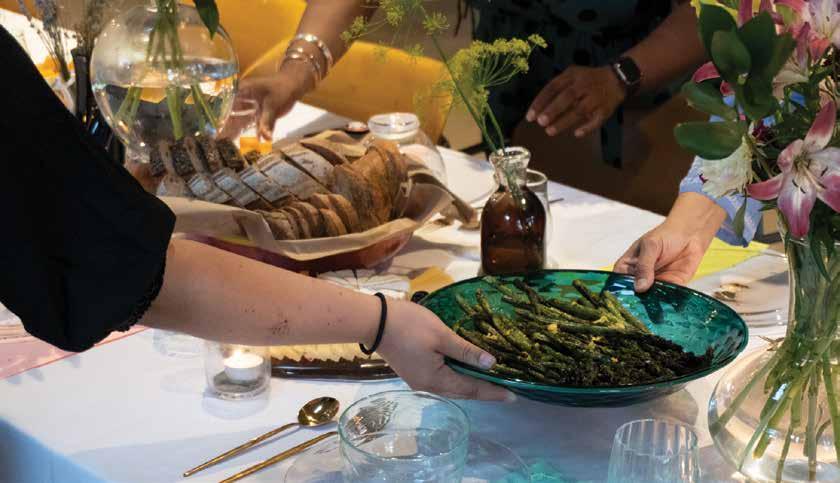 WRITTEN BY: SHANLEY POOLE // PHOTOGRAPHY BY: YEJI KIM
WRITTEN BY: SHANLEY POOLE // PHOTOGRAPHY BY: YEJI KIM
29 2023 SUMMER COURSE CATALOG
TABLE
During one of my earliest visits to Ox-Bow, I stepped into the Burke Glass Studio and experienced the art of glass blowing for the first time. I’d never seen the likes of it: the furnace, molten glass, and sheer precision of the artists had me rapt. That studio in particular still holds a special place in my heart, and I often seek out reasons to venture over there. The summer of 2022 was no exception.
Eager for an excuse to return to my favorite spot on campus, I volunteered to scope out the new glass course being offered. Nix, one of the students, kindly walked me over to the studio one morning and toured me around the space, re-introducing me to the furnace, kiln, and benches, as well as a collection of completed glasswork. Soon the other students arrived. For
most of them, this was their first time working with glass. Corey Pemberton introduced himself, shaking my hand after he set down a bag full of trout, asparagus, cherries, and garlic shoots. He and a few of his students had just returned from the local farmers’ market.

“Anyone have a plate for asparagus?” Pemberton asked his students. This is
not the typical question one expects from their professor, but this was not a typical intro-to-glass course. One by one, students held up wares in response to Pemberton’s oddly specific requests: water pitcher, trout platter, cherry bowl, charcuterie board, and even an asparagus plate. Fifteen minutes later they had found the proper vessels for their final evening on campus. Like many courses at Ox-Bow, the two-week long session culminates in an exhibition. But this was no ordinary exhibition. This was a farm-to-studio-to-table dinner.
“This idea was inspired by the many meals I’ve shared with friends and fellow makers using hand made objects,” Corey later shared, “and by the intense bonds that are formed in a glassblowing studio.”
Despite having only one day left, the students had a decent amount of production ahead of them and they were about to learn one of the most essential lessons of the course.
“Alright, today we’re doing an assembly line of cups,” Pemberton announced. Throughout the week students have been working on their own pieces, start to finish. But Pemberton was about to shake
30 FROM THE STUDIO TO THE TABLE
things up. Each student would take a small portion of the process. The glass studio is typically a place where artists must collaborate with one another: opening and closing furnace doors, grabbing instruments, and shielding each others’ arms from the heat. That day’s collaborative exercise took their chemistry and trust to a new level.
The 2022 Studio Co-Manager
Yashodhar Reddy said it’s a helpful process to learn, one that’s not often taught. “This is what it looks like in a lot of professional settings,” Reddy noted. In Pemberton’s words, through this method “emphasis [is] placed less on the individual objects, and more on the overall experience, as well as the power of collaboration.” When a student asked about another’s role in the process, Pemberton stopped them. “You don’t need to worry about what she’s doing.” In this style of glass making, each student is tasked to mind their own business, to focus on one small step in the process.
Pemberton’s teaching style exists in the liminal space between critique and camaraderie. One moment you might witness him offering much needed criticism, but minutes later you’ll catch him dancing across the studio floor when a student queues up a particularly catchy song. In essence, Pemberton fits right in with the spirit of Ox-Bow. Intense learning surrounded by intentional community. “It was the summer solstice and Beyonce had just dropped her single ‘Break my Soul’ and it was pulsing through the studio,” Pemberton recalled, “We worked hard, but still managed to take time to go to the beach, get root beer floats, and mingle with students from other [courses] around the bonfire.”
By the end of my afternoon with Pemberton and the students, they had produced an additional 15 cups. Outside of a few casualties throughout the process, it seemed each glass turned out better than the last.
The next day the table was set for a feast at 9:00 p.m., just in time for the evening light to cozy in behind the lagoon – and late enough for the woodland faeries to make an appearance. The students, Pemberton, and a lucky few guests arrived in flower crowns and flowy garments. Two weeks in the studio had led to this celebration, as had a long day in the kitchen for the Hospitality Department. Culinary Director Nicholas Jirasek and his team helped prepare fresh bread, grilled asparagus, herb-adorned trout, and two towering cakes for the event.



Pemberton noted that what first drew him to glass was “the obvious sensory experience” of the art form. The dinner cultivated a kindred ambiance. The rustle of trees, the twinkle of lantern lights, a curated tablescape, and the scents of the Ox-Bow’s kitchen – they all coalesced into a moment best described by the name of the dinner exhibition itself: Summer Solstice Woodland Fairie Realness.
True to the nature of art, especially glass, the intricacies of this course are never to be repeated. The same group of students will not gather together nor will the pieces they created ever find their way to the same table again. It was a fleeting and charmed moment. But that’s not to say that Corey Pemberton won’t be back. During the summer of 2023, Pemberton will teach a similar course; one that is sure to attract another bunch of one-of-a-kind artists who will create their own wares and feast. The course, aptly named “The Dinner Party,” is destined for enchantment – and you can bet that I’ll somehow find an excuse to pay that class a visit.
This story was written by Ox-Bow’s Engagement Liaison, Shanley Poole. Shanley is leading Ox-Bow’s growing Alumni Engagement efforts and will be frequently meandering around campus looking to engage with students, faculty, residents, and visiting artists. If you have ideas for stories or you’d like a special class project to be captured for our upcoming course catalog, reach out to Shanley at spoole@ox-bow.org


31 2023 SUMMER COURSE CATALOG
Meet Our Faculty
I was absolutely honored to be able to work with Dove, Saffronia, and my classmates in making the mosaic installation outside of the Ceramics Studio at Ox-Bow.
I was completely new to all forms of clay making and both Dove and Saffronia were super supportive and generous with their time in making sure that I was able to learn all the different processes giving me the confidence to grow as an artist.”
- Sebastian Thomas, 2022 Mosaics in Strata student
Madeleine Aguilar
Claire Arctander (Pre-College Faculty)
Joseph & Sarah Belknap
Samantha Bittman
Chris Bradley
Bri Chesler
Ling Chun
Jessee Rose Crane
Henry Crissman
Israel Davis
Josh Dihle
Brandon Donahue
E. Saffronia Downing
Nia Easley
Chris Edwards
Minhi England
Douglas R. Ewart
Salvador Jiménez Flores
Annalise Flynn
Ashley M. Freeby
Jessica Gatlin
Lucy Gillis
Lauren Gregory
Carrie Gundersdorf
Brent Harris
Dove Hornbuckle
Christalena Hughmanick
Will Hutchinson
Lesley Jackson
Dr. Dianne Jedlicka
Gunjan Kumar
Fathye Levine
Carmen Lozar
Devin T. Mays
Danny Miller
Rachel Niffenegger
B. Ingrid Olson
Turtel Onli
Kristina Paabus
Corey Pemberton
When I came to Ox-Bow, I had never worked with metal before. Jessee and Mike immediately made me feel comfortable working with processes that typically would have made me too nervous to even give it a shot. It was amazing to look up while working and see my other classmates grinding, welding, and cutting all in the same place! My favorite moments were when we would inflate our larger pieces in the glass studio’s glory hole because you never knew how much bigger they would get after a round of being in the forge and some pressurized air!”
- Marshall Moore, 2022 Inflatable Steel student
Andrea Peterson
John Preus
Joann Quinones
Padma Rajendran
Yashodhar Reddy
Scott Reeder
Ciel Rodriguez
Joseph Mario Romano
Amanda Salov
H Schenck
Liesl Schubel
William Sieruta
Jaclyn Silverman
Laurel Sparks
Barb Smith
Ruby T
Virginia Torrence
Matt Urban
Charlie Vinz
Casey Weldon
Rachel Eulena Williams
bex ya yolk
32 2023 SUMMER COURSE CATALOG
MADELEINE AGUILAR tells stories, builds archives, maps spaces, constructs furniture, records histories, organizes data, catalogs objects, prints publications, creates frameworks, collects imagery, learns trades, ties knots, repurposes materials, imitates structures, utilizes chance, plays instruments, follows intuition, prompts participation, guides observation, leaves evidence, develops routines, takes walks, breaks habits, and makes lists. She received her MFA at the School of the Art Institute of Chicago and is currently the Print & New Media Studio Manager at Ox-Bow School of Art and Artists’ Residency. Her work lives in the Joan Flasch Artist Book Collection, Franklin Furnace Archive, and the Jorge Lucero Study Collection and she has performed at the Museum of Contemporary Art in Chicago, the DePaul Art Museum, and Experimental Sound Studio.
Artists’ Coalition, Western Exhibitions, and solo shows at The Arts Club of Chicago and at the Museum of Contemporary Art Chicago. Their work was included in the book, ‘Weather as Medium’ by Janine Randerson, in the Leonardo Series through MIT Press.
Contemporary Art Raleigh, and has been included in group shows at The Renaissance Society, Atlanta Contemporary, Museum of Contemporary Art Santa Barbara, Museum of Contemporary Art Detroit, the NRW-Forum, and the Elmhurst Art Museum. He received his MFA degree from the School of the Art Institute of Chicago in 2010. In addition to his studio practice, he is an instructor of sculptural practice at both SAIC and the University of Chicago.
SARAH & JOSEPH BELKNAP

are interdisciplinary artists and educators. Stretching and playing with pareidolia and image making, their work draws on conspiracy theories, science, and sci-fi. Working as a team since 2008, their art has been exhibited in artist-run exhibition spaces in Springfield, Brooklyn, Detroit, Minneapolis, Kansas City, and St. Louis. In addition, they have presented performances at institutions throughout Chicago, including the Chicago Cultural Center, Hyde Park Art Center, Links Hall, and the MCA. Their work has been shown in group exhibitions at SFAI Galleries, San Francisco, California; the Columbus Museum of Art, Columbus, Ohio; The Arts Club of Chicago, the Chicago
SAMANTHA BITTMAN is a visual artist and educator based in Woodstock, New York. She works with woven patterning to generate paintings, graphic wallpapers, and tiled installations. She has participated in residency programs at the Josef and Anni Albers Foundation, Sharpe-Walentas Studio Program, Skowhegan School of Painting and Sculpture, Bemis Center for Contemporary Art, and Ox-Bow School of Art. In 2012, she received the Artadia Award. Recent solo exhibitions include, Ronchini, London; Andrew Rafacz, Chicago; and Morgan Lehman, New York. She has been included in numerous group exhibitions including David Castillo, Miami, Florida; Shane Campbell, Chicago; and Rhona Hoffman, Chicago. In 2022, she founded Catskill Weaving School, an artist-run school that offers in-person and online weaving and weaving-related workshops, based in Catskill, New York. She holds an MFA from The School of the Art Institute of Chicago and a BFA from Rhode Island School of Design.
BRI CHESLER is a multidisciplinary artist focusing on threedimensional design and sculptural installation. Chesler’s work is known for its nontraditional approach, combining different glass techniques with other media. Drawing from the wild and erotic character of the natural environment her work reflects on cultural obsessions of beauty and desire. By fusing similar elements found in biology and botany she creates forms that ‘flirt’ with the audience. The sensual and organic aesthetic of glass captured the essence of Chesler’s work in a way that her prior work in metal did not. Bri Chesler was a 2019 Pilchuck Emerging Artist-in-Residence, a 2020 Hauberg Fellow, a Saxe Emerging Artist Award recipient in 2021. Chesler was also awarded the Chihuly Gardens and Glass Anniversary Scholarship. In 2022 she was an instructor at Pilchuck Glass School and was featured at the Center on Contemporary Arts in Seattle with a solo exhibition.
Chun’s practice focuses on creating artifacts which speak about history with a contemporary sensibility. In her creative projects, Chun brings together her knowledge of Chinese culture and her contemporary artistic vision. Chun aspires to create public artifacts to bring relevance to historical storytelling in her future artistic pursuits. Chun is the recipient of numerous awards including the ArtBridge Fellowship 2020 sponsored by Chihuly Garden and Glass and the national ceramic award such as NCECA emerging artist 2020. In 2019, Chun was shortlisted for the Young Master Art Prize in London and recently she was shortlisted for 2021 Korea International Ceramics Biennale. Chun is currently based in Seattle. She works as a ceramic educator at North Seattle College and also as an educational guide for the Wing Luke Museum.
HENRY JAMES HAVER CRISSMAN

CHRIS BRADLEY, born 1982, New Jersey, USA, is an artist based in Chicago. He has recently presented his work in solo exhibitions at the Museum of Contemporary Art Chicago, Shane Campbell Gallery, Roberto Paradise, and the Museum of
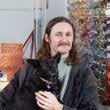


LING CHUN (she/her) is a multimedia artist from Hong Kong. Her work represents the coexistence of multicultural identities within a single society.

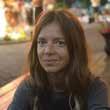

JESSEE ROSE CRANE is a multidisciplinary sculptor, arts administrator, and musician based in New Douglas, Illinois. Her approach to sculpture joins technical skills with a creative process that encourages play and embraces art in the everyday. Her practice combines steel with various media to craft both functional objects and conceptual experimentations used in exhibitions, videos, and live performances with her band Glow in the Dark Flowers. She received her MFA from Southern Illinois University Edwardsville and her BFA from The School of the Art Institute of Chicago. She is the director of Rose Raft, an artist and musicians’ residency founded in 2015. In her most recent sculptural work, she fabricates steel armatures to prop up large curtainlike vivid membranes made from glue and food coloring.
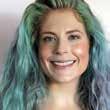
is an artist and educator who thinks of his art as a means, not an end. His work extends from a practice of making pottery, sculpture and images to include installations, collaborations, and structures, which explore the sites and methods of ceramics’ creation, distribution, and use. He earned a BFA in Craft from the College for Creative Studies in Detroit, Michigan in 2012, and an MFA in Ceramics at Alfred University in Alfred, New York in 2015. He now lives and works in Hamtramck, Michigan, where he and his wife and fellow artist, Virginia Rose Torrence, founded and co-direct Ceramics School, a community ceramics studio and artist residency. He regards teaching as an integral aspect of his creative practice. In addition to teaching at Ceramics School, he is an adjunct professor in the Craft and Material Studies Department at the College for Creative Studies in Detroit.
ISRAEL “IZZY” DAVIS is an artist whose work is concerned with dreams, wanderlust, relationships, and particulars. It is an investigation of the symbols, people, and objects that affect perceptions, the subconscious, and life experience. A study of metaphor through authenticity and fantasy that is driven by the physicality of materials and the intersection of two and threedimensional formats. Davis seeks to play between the boundaries of object and image. He is a professor and head of ceramics at Central Michigan University. He has taught over 50 workshops on his techniques for screen-printing on clay and has been included
33
in over 100 exhibitions. Izzy produces primarily functional and non-functional ceramic works ranging in content from personal narratives, observations, and just plain fun. Davis is a 20-year Ox-Bow alumni.
the Bellevue Art Museum. In 2022, she was featured on the Netflix hit series, Blown Away Season 3, earning her place as the runner up competitor.
JOSH DIHLE received his MFA in Painting from the School of the Art Institute of Chicago in 2012 and a BA from Middlebury College in 2007. He has had solo exhibitions at M+B, Los Angeles; Andrew Rafacz, Chicago; 4th Ward Project Space, Chicago; McAninch Arts Center, Chicago; and Valerie Carberry Gallery, Chicago. Dihle’s work has been exhibited in group shows internationally, including MASSIMODECARLO Vspace, Milan, Italy; Hyde Park Art Center, Chicago; Rover, Chicago; Elmhurst Art Museum, Elmhurst, Illinois; IAM Gallery, New York; Flyweight Projects, New York; Essex Flowers Gallery, New York; Ruschman, Mexico City; and Annarumma Gallery Naples, Italy. In 2021, he was the artist-in-residence at Kunstmeile Krems, Austria. His work and curatorial projects have been written about in The New York Times, New City, Artspace, The Washington Post, and Artsy. Josh Dihle lives and works in Chicago.
E. SAFFRONIA DOWNING works with wild clay to create sitespecific sculpture and installation. Downing forages material from local landscapes to consider the correspondence between maker and matter. She received her MFA in Ceramics from the School of the Art Institute of Chicago. Her work has recently been featured in exhibitions at Roots & Culture Contemporary Art Center, Chicago, Illinois; SPACE, Portland, Maine; Bad Water, Knoxville, Tennessee. Downing has received awards and residencies such as ACRE Residency, the Ox-Bow LeRoy Neiman Fellowship, and the Lunder Institute for American Art Fellowship. She is currently a teaching fellow at College of the Atlantic in Bar Harbor, Maine.
CHRIS EDWARDS (he/him) makes work that focuses on paying attention, taking time, practicing caring about things, and being at home. He currently primarily makes quilts and pottery in the pursuit of making art that is fun, funny, and nice. He thinks a lot about how we live with art. He received his Master of Fine Arts in Painting and Drawing from SAIC in 2011 and his Master of Social Work from the University of Iowa in 2014 while also completing a term of service with Americorps. He is a Licensed Clinical Social Worker and works as a psychotherapist in addition to his art practice. He lives in Chicago with his husband, dog, and two cats. He has exhibited work at Tusk, LVL3, Oggi Gallery, Dreamboat, Western Exhibitions, and Julius Caesar in Chicago.
DOUGLAS R. EWART, Professor
spacesarchives.org), for the Kohler Foundation. Flynn’s work centers on highlighting vernacular creative activity, using material, collective memory, and place as research pillars. She’s an alum of Northwestern University and the School of the Art Institute of Chicago and is based in Sheboygan, Wisconsin, with her husband and two dogs.
BRANDON J. DONAHUE is a multi-disciplinary artist who works primarily in painting and assemblage. Donahue received his BS from Tennessee State University and MFA from The University of Tennessee in Knoxville. Donahue has exhibited nationally and internationally including the 13th annual Havana Biennial in Matanzas, Cuba in 2019. Donahue lives and works in Baltimore, Maryland.



NIA EASLEY is a Chicago-based artist, designer, researcher, and educator. Those roles often intersect and overlap. She earned her MFA in Visual Communication Design and practices an art informed by methods of design production. This work engages the absurdity, violence, and beauty of contemporary American life, focusing on our shared histories and how they have shaped the current landscape. She has taught workshops at Lekòl Kominotè Matènwa, UIC (Gallery 400), and Yale University. Most recently she is a Lecturer at the School of the Art Institute of Chicago. She also holds the role of contributing Editor/Curator for the EXIT section of Interactions (IX) Magazine. Her artist’s books can be found at the Joan Flasch Artists’ Book Collection, the University of Iowa, Northwestern University, and DePaul University.


MINHI ENGLAND is a Seattle based multi-disciplinary artist working primarily in glass. She is a professional glassblower, designer, and independent artist in the greater Seattle area. Minhi’s work explores the soothing nature of repetition. Influenced by mass production and the hardships of poverty, she creates in multiples, with reiteration, and pattern. Her current art practice focuses heavily on her recent young widow status, as she navigates overwhelming loss, grief and life altering transition. Drawn to the unique properties of molten glass, her sculpture and design tend to personify the material, giving it permission to embody “self.” England has been awarded several artist residencies including the Hauberg Residency at Pilchuck Glass School, Pittsburgh Glass Center Residency, the Hilltop Artists Residency and has shown at
Emeritus at The School of the Art Institute of Chicago, was born in Kingston, Jamaica, in 1946. His life and his wide-ranging work have always been inextricably associated with Jamaican culture, history, politics, and the land itself. Professor Ewart immigrated to Chicago in 1963, where he studied music theory at VanderCook College of Music, electronic music at Governors State University, and composition at the School of the Association for the Advancement of Creative Musicians. Professor Ewart’s varied and interdisciplinary work encompasses music composition, painting and kinetic sound sculpture, and multi-instrumental performance on a full range of instruments of his own design and construction for which he is known worldwide. His visual art and kinetic works have been shown at Museum of Contemporary Art Chicago, the Ojai Festival, Art Institute of Chicago, Institute for Contemporary Art (Philadelphia), Contemporary Arts Museum Houston, and Chicago’s Museum of Science and Industry.

Through the use of natural materials, poetic language and minimalism, ASHLEY M. FREEBY explores site, monuments and data as a way to investigate the essence of memory across our land as a way to create legacy. Her recent solo and dual exhibitions include (un)sterile soil at Gallery 102 in D.C. (2020), Plots & Hems at Hyde Park Art Center (2019), As gesture at Chicago Artist Coalition (2019), Non-constants at The Annex @ Spudnik Press (2019), and Unjustified Patterns at Kanzlei, Berlin (2018). In addition, she has participated in group exhibitions in D.C., Miami, Chicago, Toronto, and Pennsylvania. She previously was a Halcyon Arts Lab Fellow in D.C. and a HATCH Projects Resident in Chicago. She has also attended Vermont Studio Center and the Institut für Alles Mögliche in Berlin Germany. Freeby was awarded the SPARK grant. She earned her MFA from the School of the Art Institute of Chicago and a BA from Bucknell University. Freeby currently works for Ox-Bow School of Art & Artists’ Residency as Director of Communications & Head Designer.
ANNALISE FLYNN is an independent art historian and curator, and the principal of Vernacular Art Services LLC. In that role, she manages SPACES–Saving and Preserving Arts and Cultural Environments, the world’s largest repository of archival documentation related to artist-built environments (www.


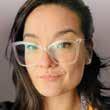

34 2023 SUMMER COURSE CATALOG
JESSICA GATLIN is an artist, maker and part-time sorceress based in Baltimore. She received her BFA in Studio Art from Florida
State University and MFA from the University of Tennessee, Knoxville. Recent projects include a collaborative contemporary art and craft home exhibition space, a web-based commission for the Miller ICA at Carnegie Mellon University, and installations that visualize an imagined relationship between gut health and mental health. She has participated in residencies and fellowships including Ox-Bow School of Art & Artists’ Residency, the Wassaic, ACRE, and the Eugeniusz Geppert Academy of Fine Arts. In 2019, she joined the faculty at the University of Maryland, College Park as an Assistant Professor of Print & Extended Media. Gatlin takes both speculative and terrestrial approaches to deconstruct and destroy a White Supremacist Capitalist Patriarchy that has rendered her and many others invisible.
LAUREN GREGORY (she/her/hers)
LUCY GILLIS is a multi-media artist, with a focus on light, glass, labor, and ephemera. Born and raised in a small-town in Southwestern Virginia, Lucy discovered glassblowing while earning her BFA from Virginia Commonwealth University. Captivated by the singular and magical properties of this medium, Lucy has traveled throughout the United States to Penland School of Crafts, Pilchuck Glass School, Haystack Mountain School of Crafts, and Ox-Bow School of Art and Artist Residency to pursue the skills needed to expand her work with glass. After completing her MFA education at Tyler School of Art and Architecture at Temple University, Lucy became the premier glass fellow at Ox-Bow in 2020, and returned as the Glass Technician in 2021. Lucy has lived in Chicago since late 2021, and is a production glassworks artisan at West Supply, a bronze and glass foundry that specializes in highend and custom furniture.
is a painter, animator, educator, and director, best known for her technique of oil paint stop-motion animation. Lauren is the third in a lineage of southern female painters, following in the footsteps of her mother and grandmother. She received an MFA from the School of the Art Institute of Chicago in 2009, and since then has created GIFs, looped video installations, and narrative animated shorts that have screened at MoMA P.S.1, the New Museum, MOCA Los Angeles, and film festivals. She has directed and animated music videos for artists including Toro y Moi, Leonard Cohen, and Norah Jones, and has been awarded artist residencies in Hungary, Italy, and in Newburgh, New York. Lauren teaches at Parsons School of Design and Ox-Bow School of Art and Artists’ Residency. She is represented in New York by the Elijah Wheat Showroom and in Nashville by the Red Arrow Gallery.


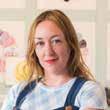
reviewed in Art Review, Artforum. com, Artnet, Art on Paper, Chicago Tribune, and Time Out Chicago. She was awarded the Artadia Award and the Bingham Fellowship from the Skowhegan School of Painting and Sculpture. Gundersdorf received her BA from Connecticut College and her MFA from School of the Art Institute of Chicago. She lives and works in Brooklyn.
CARRIE GUNDERSDORF’s works on paper reference early modernist painting and images of natural and astronomical phenomena. Her work aims to expose small moments of discovery through subject matter and process. Gundersdorf has exhibited in solo shows at the Korn Gallery, Drew University, Madison, New Jersey; Museum of Contemporary Art, Chicago, Illinois; and Shane Campbell Gallery, Chicago. Her group exhibitions include 106 Green, New York; Gallery 400, University of Illinois, Chicago; Hyde Park Art Center, Chicago; Marc Foxx Gallery, Los Angeles; and Kavi Gupta Gallery, Chicago. Gundersdorf’s work has been
BRENT HARRIS 's world and his work is created in Kalamazoo, Michigan, where he resides with his two children. Brent received his BFA from Western Michigan University in 1994. Immediately afterwards feeling the need to do more for his community he put his art career on the back burner and worked as a paramedic for seven years. In 2003 he bought the Alchemist Sculpture Foundry, where he once mentored at. The Alchemist made a name for itself creating large scale work of national importance. Brent has shown in galleries and public spaces throughout the Midwest. His sculptures can be seen in collections in New York, Chicago, and London. Currently he is Head of the Sculpture Department at the Kalamazoo Institute of Arts teaching and developing new programming. He also enjoys working in the public schools as a teaching artist for Education for the Arts. Brent teaches at Ox-Bow and the Kalamazoo County Juvenile Home.
been held in Chicago, Illinois at Goldfinch Gallery, To Hear a Call, To Answer a Call, 2023 and Roots & Culture, Earth, My Likeness, 2020. Past awards include a teaching fellowship from the Vermont Studio Center in 2020, and the LeRoy Neiman Fellowship from the Ox-Bow School of Art in 2018. Past teaching roles have been held as Adjunct Professor in the Art and Art History department at Hope College, lecturer at the School of the Art Institute of Chicago in the Ceramics Department and instructor at the Ox-Bow School of Art & Artists’ Residency. They have served as the Ceramics Studio Manager at the Ox-Bow School of Art & Artists’ Residency since 2019.

WILL HUTCHINSON holds an MFA from The University of Montana and BFA from The Art Academy of Cincinnati. He is a former smokejumper and all-around adventurer. His work includes objects both functional and sculptural in a variety of materials. He is a proud dog dad of a puppy named Penny...



DOVE HORNBUCKLE (they/ them) is an interdisciplinary artist working within ceramic sculpture, queer community organizing, and radical faerie traditions. Previous solo exhibitions have

CHRISTALENA HUGHMANICK ’s practice engages with human relationships between craft and labor, and the scaled production systems that have generated these histories. She takes a theoretical approach related to cultural anthropological studies, which is enacted through fieldwork that captures vernacular knowledge production systems that may disappear. Her paper “Freedom Quilt: Collective Patchwork in Post-Communist Hungary” has been presented at The Textile Society of America’s 17th Annual Symposium and will be published in the Bloomsbury Encyclopedia of World Textiles in 2023. She has exhibited internationally and been an artist in residence at the American Academy in Rome; SÍM, Reykjavík; the Moholy-Nagy Művészeti Egyetem, Budapest; and Wedge Projects, Chicago. Her work has been supported by the Fulbright Foundation, US State Department, Lenore Tawney Foundation Scholarship, among others. She holds an MFA from the School of the Art Institute of Chicago.
B. INGRID OLSON implements elements of photography, sculpture, and performance in an ongoing exploration of the perceptual and conceptual relationships between bodies: her own, viewers’, architectural, and textual. Whether captured with a camera, machine carved or cast, her work tests the capacities of bodies and the space around them. Solo exhibitions include two simultaneous exhibitions at the Carpenter Center for the Visual Arts at Harvard University (2022); Secession, Vienna (2022); Albright-Knox Art Gallery, Buffalo (2018). Olson’s work was featured in a two-person exhibition at The Renaissance Society at the University of Chicago (2017). Recent group exhibitions include Fata Morgana, Jeu de Paume, Paris (2022); The Inconstant World, Institute of Contemporary Art, Los Angeles (2021); Dependent Objects, Museum of Contemporary Art, Chicago (2021); New Visions, Henie-Onstad Kunstsenter, Høvikodden, Norway (2020); Being: New Photography, The Museum of Modern Art, New York (2018); Lost Without Your Rhythm, Aspen Art Museum, Colorado (2018).
LESLEY JACKSON is a Chicago based artist and educator. She spends most of her days at work in a furniture shop, dreaming about a radically different world where humans and objects are less at odds with one another. Lesley recently started The School of Many Questions, a small, donation-based craft school that runs out of her studio and is open to the public.
Lesley received her BFA from The School of the Art Institute of Chicago in 2013. She has shown most recently with Jonald Dudd for NY Design Week, New York; Goldfinch Gallery, Chicago; Murmrus, Los Angeles; Andrew Rafacz Gallery, Chicago; Greenlease Gallery, Kansas City; Hotel Art Pavilion, New York; Bar4000, Chicago; Efrain Lopez Gallery, Chicago; Chicago Artist Coalition, Chicago; Forth Ward Project Space, Chicago; Heaven Gallery, Chicago; and NADA Art Fair with Hotel Art Pavilion (2018) and SPF15 (2016).
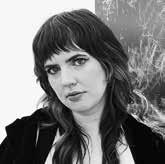

SALVADOR JIMÉNEZ-FLORES

is an interdisciplinary artist born in México. Jiménez-Flores has presented his work at the National Museum of Mexican Art, Grand Rapids Art Museum, Urban Institute of Contemporary Art, Bemis Center for Contemporary Arts, and Museum of Art and Design amongst others. He served as Artist-In-Residence for the city of Boston, Harvard Ceramics Program, Office of the Arts at Harvard University, and Kohler Arts Industry. JiménezFlores is a recipient of Joan Mitchell Foundation Painters & Sculptors Grants and The New England Foundation for the Arts, Threewalls’ RaD Lab+Outside the Walls Fellowship Grant, and he is a 2021 United States Artist Fellow. He is an Assistant Professor in Ceramics at the School of the Art Institute of Chicago.
Asian Arts Fund (The India Center, New York), SPARK grant (Chicago Artist Coalition) and Propeller Fund (ThreeWalls). She is currently a resident at the Chicago Art Department. She has been a recipient of the Edward Albee Foundation residency, Montauk, New York (2016-2017).
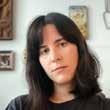
DR. DIANNE JEDLICKA teaches numerous Biology courses at SAIC including Animal Behavior, Evolutionary Mammalogy, Ecology (Natural History), and Human Anatomy and Physiology. Her primary research has been at the community level of organization, focusing on the feeding strategies and predation of tree and ground squirrels based on their functional morphology. Observational data collected on nocturnal foraging of the eastern cottontail rabbit was published recently. All of these animals are found throughout the OxBow region and offer Dr. Jedlicka’s students ample opportunity for scientific observations. Dr. Jedlicka has also presented and published articles on new teaching methods and labs in the college classroom.
GUNJAN KUMAR is an American Indian artist and scholar based in Chicago, originally from Punjab, India. Kumar received her Bachelor’s in Arts from DAV College for Women in Chandigarh, India, and is a postgraduate in Textiles from the National Institute of Design and Technology, New Delhi. She has spent many years observing age-old practices in textiles and indigenous arts and visiting archeological sites, particularly prehistoric cave paintings in central India. Her process involves organic matter applied as core mediums on natural surfaces with techniques inspired by traditional methods. Her works have been exhibited internationally and are a part of noted private collections globally.
Gunjan is a recipient of the South

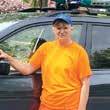
FAYTHE LEVINE advocates for creativity to be used as a vehicle to build community, personal independence, and empowerment. Motivated by reimagining archives and collections through a queer feminist lens, her practice intersects with curatorial projects, consulting, writing, documentary film, and happenings. She currently works with the Women’s Studio Workshop in Rosendale, New York assisting with research and development for the 50th Anniversary traveling exhibition. From 2017 to 2021 Levine was the director of the John Michael Kohler Arts Center Arts/Industry residency program and curated related exhibitions in Sheboygan, Wisconsin. Her most widely known projects, Sign Painters (2013) and Handmade Nation: The Rise of DIY Art, Craft and Design (2009), both feature length documentaries with accompanying books published by Princeton Architectural Press, have toured extensively in venues including the Renwick Gallery of the Smithsonian Institution, Brooklyn Museum, Museum of Arts and Design, Yerba Buena Center for the Arts, and the Victoria and Albert Museum.
experience. Lozar is a glass artist and a faculty member of the Ames School of Art at Illinois Wesleyan University in Bloomington, Illinois. She often travels abroad to teach and share her love for glass - most recently to England, Turkey, Italy, and New Zealand but always returns to her Midwestern roots. A graduate of the University of Illinois at Urbana-Champaign, she completed her post-graduate degree at Alfred University, New York, and is represented by Ken Saunders Gallery in Chicago. She has held two residencies at the Corning Museum of Glass and one at Penland School of Craft. She is included the permanent collections of the Museum of Art and Design in New York; The Museum of Glass, Washington; and the Bergstrom Mahler Museum, Wisconsin.
DANNY MILLER is an artist and musician working in Chicago. Utilizing woodblock, lithography, etching and drawing, he conjures works inspired by science fiction pulp covers, Victorian engravings, advertisements, comic books, and music. Miller has taught at Ohio State University, University of Wisconsin-Madison, School of the Art Institute of Chicago, and Ox-Bow School of Art, and was the Print Media Department Manager at SAIC for 32 years. He received his MFA from the University of Wisconsin-Madison, and has worked in professional print shops including Landfall Press, Normal Editions Workshop, and Four Brothers Press, in addition to playing and teaching traditional fiddle and banjo music at the Old Town School of Folk Music in Chicago for 11 years.

Telling stories has always been CARMEN LOZAR ’s primary objective. Some narratives are sad, funny, or thoughtful but her pieces are always about the human
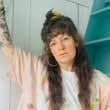
DEVIN T. MAYS (b.1985) holds a BBA in International Business and Marketing from Howard University. After receiving his degree, he worked in advertising developing brand strategies and commercials for the better part of a decade. He returned to school to pursue an MFA in studio practice from The University of Chicago. There, he developed an interdisciplinary practice he often refers to as an exercise in wandering, a practice-in-participation, a practice-in-practice. Since then, he has exhibited at the Museum of Contemporary Art, Chicago; The Driehaus Museum; Museum of Contemporary Photography; Lowe Art Museum, University of Florida; Nahmad Projects, London; DePaul Art Museum, Chicago; The Moody Center for the Arts at Rice University; Regards, Chicago; and The Gray Center among others. He was recently awarded the CERCL Fellowship with the Visual and Dramatic Arts at Rice University.
Devin T. Mays currently lives and works between Chicago and Houston.
RACHEL NIFFENEGGER utilizes curious and experimental media to conjure uncanny spirits. Her creations are preoccupied with fecundity and the macabre, at once psychedelic and mysterious. Rachel Niffenegger’s work has been included in museum shows at the Museum for Modern Art in Arnhem, Netherlands; the MCA, Chicago; and in gallery shows in New York, Berlin, Chicago, Liverpool, Denver, and Milwaukee, among others. In 2012 she completed a residency at DE ATELIERS in Amsterdam. Chicago Magazine named her “Chicago’s best emerging artist” in 2010 and New City named her one of “Chicago’s Next Generation of Image Makers” in 2010, after naming her the “Best Painter Under 25” in 2009. Niffenegger, born in Evanston in 1985, received her BFA from the School of the

36 2023 SUMMER COURSE CATALOG
Art Institute of Chicago and her MFA from Northwestern University in Evanston, Illinois. She is represented by Western Exhibitions in Chicago and lives and works in Chicago.

TURTEL ONLI is a Rhythmistic Visual Artist with a BFA and MAAT from the School of the Art Institute of Chicago. He has been an art therapist, educator, and illustrator. He has work in the collections of the Cool Globes Public Art Traveling Exhibition, the Chicago Children’s Museum, the DuSable Museum, the Johnson Publishing Company, the estates of Mile Davis and Alice Coltrane. Onli has also freelanced illustrations for the Rolling Stones, McDonald’s, Motown, MODE Avant Garde Magazine, the Paris Metro Magazine, Capital Records, Holt, Rinehart, and Winston. He has exhibited at the Museum of Contemporary Art, Chicago, New Museum of Contemporary Art, the Museum of Science and Industry, the Krannert Museum, the Tubman Museum, along with the Corvus Gallery of Gordon Parks Arts Hall of the University of Chicago.

participated in residencies around the globe and received a Fulbright Fellowship for Installation Art in Estonia, the Grant Wood Fellowship in Printmaking at The University of Iowa, and an Ohio Arts Council Individual Excellence Award. Based in Ohio, Paabus teaches all forms of printmaking and is an Associate Professor of Reproducible Media at Oberlin College. She has taught at SAIC, Ox-Bow, Penland, The University of Iowa, and The Estonian Academy of Arts.
environment. She was recently collected by the Watson Library at the Metropolitan Museum of Art in New York City, which recognized her as a 21st century creator of unusual handmade papers and surface design.
KRISTINA PAABUS (USA/EE) is a multidisciplinary visual artist and printmaker. Her work examines systems of power and control, with a focus on Soviet and Post-Soviet histories. Paabus earned her BFA from the Rhode Island School of Design and MFA from the School of the Art Institute of Chicago. Kristina has exhibited work throughout the US, Europe, and China. Recent solo exhibitions include Meanwhile at Hobusepea Galerii (Estonia) and Something to Believe In at the McDonough Museum of Art (Ohio). Paabus has
COREY PEMBERTON (American b. Reston, VA 1990) received his BFA from Virginia Commonwealth University in 2012. He has completed residencies at The Pittsburgh Glass Center (Pennsylvania), Bruket (Bodø, Norway), as well as a Core Fellowship at the Penland School of Crafts (North Carolina). He currently resides in Los Angeles, California where he splits his time between the nonprofit arts organization Crafting the Future, glass blowing, and his painting practice. Pemberton strives to bring together people of all backgrounds and identities, breaking down stereotypes and building bridges; not only through his work with Crafting the Future but with his personal artistic practice as well.
JOHN PREUS developed his practice from roots in painting and furniture-making and his collaborative work with Material Exchange in graduate school at the University of Chicago. He grew up in Tanzania to Lutheran missionaries, which influenced how he thinks about materials, appropriation, the possibility of shared ethical norms, and clash of cultures. Preus is a fabricator for other artists and designers, which has influenced his thoughts on authorship and collaboration. Preus has been an Interpreter in Residence at the Smart Museum, a Kaplan resident at Northwestern University, a nominee for the US Artist Fellowship, and was included in New City’s Chicago Art 50 in 2016. He was a JackmanGoldwasser resident at the Hyde Park Art Center, a Efroymson Fellow, and a first place winner of the Maker grant. Recent solo exhibitions include A State of the Union at Pentimenti Gallery in Philadelphia and The Beast: Herd Mentality at the Montserrat College of Art.

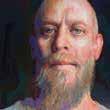
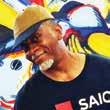
Prize Finalist, and received an Honorable Mention for the James Renwick Alliance Chrysalis Award. Her work has been shown nationally at institutions such as the Belger Arts Center, the Akron Art Museum, and the Northern Clay Center. She has participated in residencies at Vermont Studio Center, Winterthur Museum, Garden, and Library, and the John Michael Kohler Arts Center. She has an MFA in Studio Art from Indiana University, Bloomington, and a Ph.D. in English from the University of Iowa. She is currently an Assistant Professor of Sculpture - Mixed Media and Fibers at Alfred University.
ANDREA PETERSON is an artist and educator. She lives and creates work in northwest Indiana at Hook Pottery Paper, a studio and gallery co-owned with her husband. She teaches at The School of the Art Institute of Chicago. She combines paper arts, printmaking and book arts to make works that address the human relationship to the

JOANN QUIÑONES is a Fibers and Ceramic artist who creates mixed media work which explores queer, Afro-Latinx identity. Her practice includes sculptural approaches to fibers, surface design, natural dyes, and mold-making. She was selected an Emerging Artist of 2020 by Ceramics Monthly, was a Manifest Gallery Annual
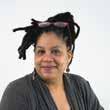
PADMA RAJENDRAN was born in Klang, Malaysia. She studied at Bryn Mawr College and received her MFA from Rhode Island School of Design. She teaches drawing at Vassar College. She has exhibited at the International Print Center, New York; Ortega y Gasset Projects, Brooklyn; Beers, London, UK; Field Projects, New York; September Gallery, Hudson, New York; BRIC Arts Media, Brooklyn; Aicon Gallery, New York; Taymour Grahne Gallery, London, UK; and most recently a solo show at SE Cooper Contemporary, Portland, Oregon. She lives and works in Catskill. Her works on fabric experiment with the clash and combination of patterning and storytelling. Her rich compositions reference the duality and contradictions of culture and the multi-facetted definitions of universal heritage. She has completed residencies at Ortega y Gasset Projects, the Studios at Mass MoCA, Women’s Studio Workshop, Ox-Bow, and Lower East Side Printshop.

YASHODHAR REDDY is an Indian-American glass artist from Central Pennsylvania. His work focuses on the traditional aspects of glass craft and design from a functional viewpoint. Refining form and technique through the study of tableware, lighting fixtures, and abstract sculpture. He draws inspiration from the aesthetics of traditional European glass objects, with the intention of rendering his works with more relevant and personal styles. His education began at Harrisburg Area Community College where he was introduced to the medium and from there continued to travel the world to study with prestigious glass artists such as Karen Wilinbrink-Johnsen, Darin Denison, and Davide Fuin. He has a diverse working experience ranging from design firms like Niche Modern and AO Glassworks to educational organizations such as the prestigious Corning Museum of Glass, where he has been on the team of many reputable artists such as Fredrik Nielsen, Martin Janecky, and Jiyong Lee.
SCOTT REEDER (b. Battle Creek, MI) is a multidisciplinary artist who uses deadpan humor and cultural critique to expose the absurdity of life. His newest series draws from the traditions of still-life painting to project emotional affect and social relationships onto inanimate objects. Reeder first became known for his text-based paintings and parodies of process painting, as well as for his feature-length improvised sci-fi film titled Moon Dust and his possibly ironic art fairs (The Milwaukee International and Dark Fair.) Reeder is based in Chicago, where he is an Associate professor at The School of the

37
Art Institute of Chicago. Solo and two-person exhibitions include: Museum of Contemporary Art, Chicago; John Michael Kohler Arts Center, Sheboygan; Gavin Brown’s Enterprise, New York; Luce Gallery, Torino, Italy; and Jack Hanley, San Francisco, CA. A book on Reeder’s work titled Ideas (cont.) was published by Mousse in 2019.
feels connected when he is outside painting. When he was in Graduate School at the Art Institute of Chicago, he had the opportunity to look through a sketchbook filled with Cézanne’s Watercolors, which he pinpoints as a pivotal moment in his life as an artist. Romano currently resides in Upstate New York. He graduated from the Art Institute of Chicago with his Masters of Fine Arts in 2012. After graduating Mario has shown at galleries both Nationally and Internationally, including Chicago, New York, Austin, and Germany.
CIEL RODRIGUEZ is a papermaker, letterpress printer, bookbinder, photographer, possible poet and who knows what else. Continually inspired by our connections with nature, she embeds natural materials into her handmade paper collages and uses the gestures of plant life to embody emotions and gestures we identify within our human selves. Rodriguez’s artistic practice focuses on enveloping her viewers and readers in quiet expanses, evoking states of mind or states of remembrance. She completed her BFA at the School of the Art Institute of Chicago with a focus in analogue photography and papermaking. She received her Master of Fine Arts from the University of Georgia in Printmaking & Book Arts, as well as Museum Studies. While at UGA, Rodriguez was awarded the Wilson Center Graduate Research Grant for her explorations in large scale papermaking. She is an exhibition committee volunteer for North American Hand Papermakers (NAHP) and currently works at the Michael C. Carlos Museum in Atlanta, GA.
AMANDA SALOV is an artist whose work examines the qualities of a moment, or the idea of a moment in physical form: temporal, fragile and fleeting. These moments are plastic, sometimes they seem to stretch translucent thin, changing in strength and quality. She received a BFA focusing in ceramics and an MFA focusing in ceramics, sculpture, and fibers. Amanda has shown her sculptures and installations nationally and abroad. She also can be found painting and writing. For the past decade while living in the Pacific Northwest, she’s been grappling with infertility, a thing almost no one speaks of openly, trying to understand it from her environment and spaces surrounding her. She lives and works in the beautiful blue city of Seattle, Washington.
and place through discarded materials, art methodologies, and social concepts of value, meaning, and connection. He earned his BFA in printmaking at Bradley University and his MFA in intermedia at University of Texas Arlington. His work has been exhibited domestically and internationally at BWA Wrocław Galleries (Poland), 2nd Berlin Becher Triennial (Germany), The Modern Art Museum (Fort Worth), Urban Glass (New York), Traver Gallery (Seattle), and MAC (Dallas). Schenck has received funding from the Dallas Museum of Art, the MAC, Southern Graphics Council International, Lawrence University, Penland School of Crafts, and the Kotteman Foundation. He is an Instructional Specialist and Anti-racist Transformation Team fellow at Columbia College Chicago.
WILLIAM SIERUTA (he/him) can’t decide if he’s a painter, a sculptor, a writer, or a designer, so instead of committing to one discipline, his time is haphazardly divided between all of these pursuits. He studied Painting and Drawing at the School of the Art Institute of Chicago, where he earned an MFA in 2012. He was also awarded a fellowship to Ox-Bow School of Art, an experience he draws inspiration from to this day. After several stints as an artist assistant and studio manager in New York, William returned to his native Massachusetts where currently he teaches painting classes and workshops. He was awarded a grant from the Massachusetts Cultural Council for his “Thinking in Color” studio workshop in 2018. These days WIlliam lives and makes art on January Mountain with his wife Jennifer and his son Ziggy.
Artistic Director and piloting artist-in-residence with Chicago artist residency and non-profit organization, CPS Lives. Silverman is an adjunct faculty with Loyola University Chicago. She received her BFA in photographic studies from The Ohio State University and MFA in Studio Art from the School of the Art Institute of Chicago.
JOSEPH MARIO ROMANO chose to be a painter in Upstate New York because of its landscape, the change of the seasons, and the transient color schemes. He
H SCHENCK (he/him) is an artist and educator whose work speaks about belonging. His practice is rooted in his experience as a trans person and influenced by a transient, rural upbringing. Schenck integrates themes of identity
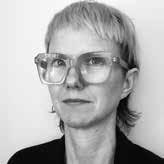





LIESL SCHUBEL was born in Ontario, Canada, and currently lives in Trenton, New Jersey. As a queer person, artist, and city dweller from rural roots, the complexity of home and of the familial remain a constant source of inspiration. Liesl is trained as a glassblower, having worked with glass for over 12 years. They are drawn to the fluidity of glass and pair it with other media to form new narratives. Liesl is a founding member of Flock the Optic, a group formed to explore the meeting place of glass, performance, installation, entertainment, and happening. Liesl received their BFA from Rhode Island School of Design. They continue traveling and pursuing opportunities to expand their understanding of art and craft at institutions such as Haystack Mountain School of Crafts in Deer Isle, Maine; Pilchuck Glass School in Stanwood, Washington; and Ox-Bow School of Art in Saugatuck, Michigan. Liesl is currently the Education Director at UrbanGlass.
JACLYN SILVERMAN (she/ her) is a photographer from Youngstown, Ohio, currently living and working in Chicago. Her work engages dynamics of family and relationships through environmental portraiture with photographic collaborations and public projects. She received the Denman Research Grant at The Ohio State University for her visual research, The Working Family. She co-curated the exhibition, Within the Portfolios 1968-2016; a History of Photography from the School of the Art Institute of Chicago at the Joan Flasch Artists’ Book Collection. Commissioned by Theaster Gates, Silverman created photographic installations published in conjunction with the exhibition, “A Johnson Publishing Story” at Stony Island Arts Bank. She is the Founding
BARB SMITH is a Queens-based artist born in Kokomo, Indiana. She holds an MFA in Sculpture from Bard College. Her work invites reflection on one’s relationship to the material world by mining the tension between seeing, touching, and recalling. Solo exhibitions include Cradle, Essex Flowers Window Box, New York; Mother Tongue, Fine Arts Center Gallery, University of Arkansas, Fayetteville, Arizona; Gravity Forgiveness, Stepsister, New York. Group exhibitions include Art Work, The Metropolitan Museum of Art, New York; The Backroom, Museo Tamayo, CDMX, Mexico; Tiny Things, September, Hudson, New York; the Invitational Exhibition of Visual Arts, and American Academy of Arts and Letters, New York. Smith was a New York Foundation for the Arts Fellow in Sculpture in 2011 and attended the Skowhegan School of Painting and Sculpture in 2012. Her writing has been featured in The Shawangunk Review, No, Dear Magazine, The Saint Lucy, Makhzin, and The Brooklyn Rail.
LAUREL SPARKS is a Brooklynbased painter whose work embodies symbols and patterns that pay tribute to counter-culture legacies. She holds an MFA from Bard College and a BFA from the School of the Museum of Fine
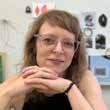
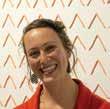
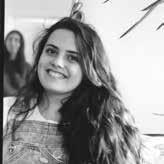
38 2023 SUMMER COURSE CATALOG
Arts, Boston at Tufts University. Exhibitions include solo shows at Kate Werble Gallery, New York; Knockdown Center, Brooklyn; and group shows at Cheim and Read Gallery, New York; Museum of Fine Arts, Boston, Massachusetts; and DeCordova Museum, Lincoln, Massachusetts. Awards include a MacDowell Fellowship, the Elizabeth Foundation Studio Intensive, Fire Island Artist Residency, Berkshire Taconic Fellowship, SMFA Alumni Traveling Fellowship, and an Elaine DeKooning Fellowship. Sparks lives and works between Brooklyn and Hudson Valley and teaches painting at the Pratt Institute in Brooklyn. Sparks recently completed an immersive installation and performances in collaboration with artist Shawn Hansen at Soloway Gallery in Brooklyn. She has a forthcoming project grant and residency at Tinworks Art, Bozeman, Montana.
VIRGINIA ROSE TORRENCE
RUBY T ’s work is an experiment in translating fantasy to reality, and she is fueled by anger, desire, and magic. Rooted in drawing, her practice has offshoots in painting, performance, comics, fibers, and video. She was named a 2018 Breakout Artist by Newcity and received her MFA from School of the Art Institute of Chicago in 2016. Selected solo and two-person exhibitions in Chicago include Western Exhibitions, Randy Alexander Gallery, Roots & Culture, and The Back Room at Kim’s Corner Food. Ruby has performed and screened video works at Iceberg Projects, Weinberg/Newton, Gallery 400, Chicago Filmmakers, and Comfort Station, all in Chicago, as well as Monaco in St. Louis, Compliance Division in Portland, and the Visual Arts Gallery at University of Illinois Springfield. Her band Lezurrexion performed in over 50 crusty basements, clubs, and secret outdooor spaces between 2011 and 2015.
(She/her) co-owns, operates and teaches at Ceramics School, a community ceramics studio and Artist Residency in Hamtramck, Michigan. Virginia’s art practice is sometimes making pottery and sometimes making sculptures. Virginia enjoys the pleasure, tangible growth and monetary accessibility of pottery, and the self-indulgence, introspection and criticality in making sculptural works made out of all sorts of things. She received her BFA in Craft/Ceramics from the College for Creative Studies (Detroit, Michigan) in 2013 and her MFA in Ceramics from Alfred University (Alfred, New York) in 2016. Virginia was a Fellow at Ox-Bow in 2012, and has been a Resident Artist at Watershed Center for Ceramics in Newcastle, Maine; Guldagergaard (Project Network) in Skaelskor, Denmark; and The White Page Gallery in Minneapolis. Virginia lives and makes art in Hamtramck, Michigan with her partner and coteacher Henry Crissman, two dogs, two cats and two parakeets.
School of Art, The Melting Point, and Art Glass Kalamazoo. Matthew worked as a Gaffer for Glass Lab with the Corning Museum of Glass. For the last 10 years had owned and operated Furnace Urbini Glass Works in Normal, Illinois where he makes his production line and commission work for artists and designers.
Fine Arts in Birmingham, Alabama where she is from. She earned her BFA at the School of the Art Institute of Chicago where she graduated with the James Nelson Raymond Fellowship Award. Weldon received her MFA at Kendall College of Art and Design with a full-ride fellowship.

MATTHEW URBAN began his art career at University of the Arts in Philadelphia as an Industrial Design student. In 1997 he received a scholarship to the Studio at The Corning Museum of Glass to study with Master Gianni Toso. After that workshop he changed his major to glass and never looked back. Since 1997 he has been on staff at Pilchuck Glass School, taught at the Studio at the Corning Museum of Glass and Penland School of Craft. Matthew has been a resident artist at Corning Museum of Glass, Penland School of Craft, Tyler
CHARLIE VINZ is an architect, designer, and artist who searches for simple solutions to complicated problems. In his approach, cultural production is an extension of the built environment, which is part of an open-ended, collaborative process. He studied architecture at the Illinois Institute of Technology in Chicago and Bauhaus Universitat in Weimar, Germany, graduating with a BArch in 2004. He has worked at architecture firms in Chicago, with artist Theaster Gates and Rebuild Foundation, and was the Creative Director of the Rebuilding Exchange before starting his own practice, Adaptive Operations, which primarily adapts buildings and spaces for new and different uses and works with artists and cultural organizations. Charlie has been a lecturer of Historic Preservation at SAIC and guest taught at the University of Chicago, Antioch College, and Washington University. He is a visiting critic at the Illinois Institute of Technology and SAIC. Charlie was an Artist-inResidence at Ox-Bow in 2016.

RACHEL EULENA WILLIAMS is an artist whose work displays an unusual level of candor, invention, and lightness. Her painted constructions employ the language of abstract painting, but are transformed through her own approach to material. Finding a balance between painting and sculpture, Williams applies larger swaths of color made from painted canvases that she subsequently cuts up and reconfigures. The collage-like works are tied together with sewing, which acts both pictorially and creates marks inside her compositions. Williams (b. 1991, Miami, Florida) received her BFA from The Cooper Union for the Advancement of Science and Art in New York. Her work has been exhibited at venues such as Xavier Hufkens, Brussels; Ceysson & Benetiere, New York, Saint Etienne & Luxembourg; The Brooklyn Academy of Music, New York; Night Gallery, Los Angeles; and Loyal Gallery, Sweden. Her work is included in the collection of the Pérez Art Museum, Miami.
at the School of the Art Institute of Chicago where they completed an MFA in Visual Communication Design with a concentration in Book Arts. They were a recipient of the Nexus Fund: Emergency Relief Grant from Atlanta Contemporary and the Relief Fund for Georgia Visual Artists. THUNGRY operates as a publishing initiative focused on disrupting what we’ve come to understand qualifies a book, complicating traditional ways of book building through experimentation and queering praxis. yolk also maintains a multiyear research practice into the ‘maternal complex.’
KC WELDON is an artist and public-school art teacher living in Chicago. She has taught at Lillstreet Art Center, Chicago Ceramic Center, and Arrowmont School of Craft. Her art education started at the Alabama School of
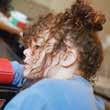
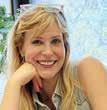


BEX YA YOLK (she/they) is a multidisciplinary visual artist, book maker, and sometimes still a practicing graphic designer. yolk is at the helm of developing an independent artists’ book bindery— THUNGRY, founded in Atlanta in 2019, now based in Chicago. yolk was a merit scholar

39
meet Our Visiting Artists
Ox-Bow is proud to platform a range of voices, ideas, and perspectives through its Visiting Artist Program. Every week, a new artist comes to campus to participate in the community, most notably through an artist talk open to everyone on campus. After the talk, a sign-up sheet is presented where anyone on campus can select a time to have a studio visit.
THE LINEUP
SESSION ONE
MAY 28 - JUNE 10
Samantha Bittman
Melina Ausikaitis
SESSION TWO
JUNE 11 - 24
Jennifer Sullivan
SESSION THREE
JUNE 25 - JULY 1
Mark Thomas Gibson
SESSION FOUR
JULY 10 - 22
LJ Roberts
Tyson Reeder
SESSION FIVE
JULY 23 - 29
Sharif Farrag
SESSION SIX
JULY 30 - AUGUST 12
Branden Fernandes
Chris Bogia
SESSION SEVEN
AUGUST 13 - 26
Nance Klehm
Hyun Jung Jun
* NOTE: In a two-week session there will be one visiting artist each week. Sharif
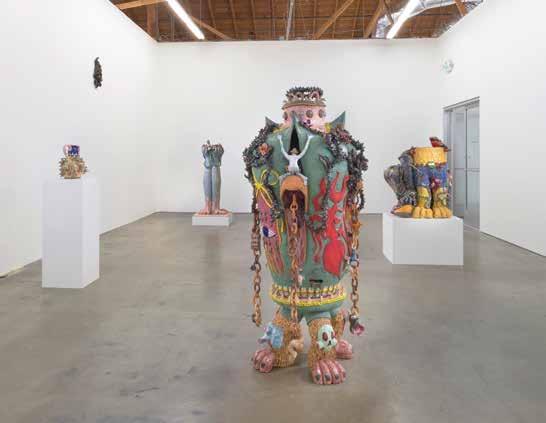
40 2023 SUMMER COURSE CATALOG
Farrag, Laugh in the dark, 201, solo Exhibition at Francois Ghebaly
SAMANTHA BITTMAN is a visual artist and educator based in Woodstock, NY. In her practice, she works with woven patterning to generate paintings, graphic wallpapers, and tiled installations. She has participated in residency programs at the Josef and Anni Albers Foundation, SharpeWalentas Studio Program, Skowhegan School of Painting and Sculpture, Bemis Center for Contemporary Art, and Ox-Bow School of Art. In 2012, she received the Artadia Award. Recent solo exhibitions include, Ronchini, London, UK; Andrew Rafacz, Chicago, IL; Morgan Lehman, NY, NY; and Greenpoint Terminal Gallery, Brooklyn, NY. She has been included in numerous group exhibitions including David Castillo, Miami, FL; Shane Campbell, Chicago, IL; and Rhona Hoffman, Chicago, IL. Her work has been written about in The New York Times, Wall Street International, and The Washington Post, amongst others. In 2022, she founded Catskill Weaving School, an artist-run school that offers in-person and online weaving and weavingrelated workshops, based in Catskill, NY. She holds an MFA from The School of the Art Institute of Chicago, and a BFA from Rhode Island School of Design
JENNIFER SULLIVAN is a painter who lives and works in Ridgewood, Queens. Her paintings are a diary and a form of psychoanalysis, that evolved from earlier work in performance and video. Recent solo exhibitions include Original Face , Deli Grocery Gallery, Ridgewood, NY (2022), Sleeper, Turn Gallery, New York, NY (2021), Devotional Paintings , Julius Caesar, Chicago, IL (2020), Female Sensibility, Emma Gray HQ, Los Angeles, CA (2020), Exiled Parts , No Place Gallery, Columbus, OH (2019), and the soft animal of your body, Emma Gray HQ, Los Angeles, CA (2018). Sullivan has exhibited widely including group exhibitions at Marinaro, Brennan and Griffin, Rod Barton, NADA Miami, and Klaus Von Nichtsaggend. Awards include fellowships with Paint School at Shandaken Projects (2020) and the Fine Arts Work Center (2012-13), and residencies at the Lighthouse Works, Skowhegan, Ox-Bow, and Yaddo. Her work has been reviewed in the NY Times, Brooklyn Rail, Artforum, and Art Papers. She is represented by Emma Gray HQ in Los Angeles, CA.
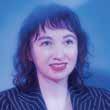
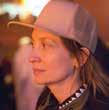
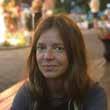

MELINA AUSIKAITIS is an artist, a dedicated musician and lyricist, a skilled seamstress, a spoken word performer, curator and playful image- and objectmaker. She has exhibited and performed all over the country and traveled the world playing in her bands Joan of Arc and Aitis Band. She is as much an inventor as an artist, and as much a librarian as a songwriter. This is an artist who incorporates so many interchanging and overlapping dimensions that it’s as if she’s created her very own genre.
MARK THOMAS GIBSON 's personal lens on American culture stems from his multifaceted viewpoint as an artist—as a black male, a professor, and an American history buff. These myriad and often colliding perspectives fuel his exploration of contemporary culture through languages of drawing, painting, print, and sculpture revealing a vision of a satirical, dystopian America where every viewer is implicated as a potential character within the story. Gibson (b. 1980, Miami, FL) received his BFA from The Cooper Union in 2002 and his MFA from Yale School of Art in 2013. He is represented by M+B in Los Angeles and Loyal in Stockholm. In 2016, he co-curated the traveling exhibition Black Pulp! with William Villalongo. Gibson has released two artist books, Some Monsters Loom Large (2016) and Early Retirement (2017). In 2021, Gibson was awarded residencies at Yaddo and the Elizabeth Murray Artist Residency. He was awarded

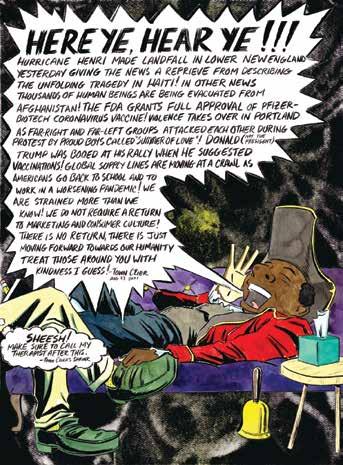 1. Melina Ausikaitis, Shirt Back, 2020, singles installation, Regards, Chicago, IL, 4 x 5 ft.
1. Melina Ausikaitis, Shirt Back, 2020, singles installation, Regards, Chicago, IL, 4 x 5 ft.
41
2. Mark Thomas Gibson, Town Crier: August 23rd, 2021, 2021, collage on paper, 30 x 44 in.
a Pew Fellowship from the Pew Center for Arts and Heritage, Philadelphia, PA and a Hodder Fellowship from Lewis Center for the Arts, Princeton University, Princeton, NJ. Gibson was most recently awarded a 2022 Guggenheim Fellowship from the John Simon Guggenheim Memorial Foundation, New York, NY. In October 2022 he had his most recent solo exhibition Here He, Hear Ye!!! at Hurley Gallery at Princeton University.
Freeman Gallery, New York; Jack Hanley, San Francisco, among others. Reeder has co-organized many group exhibitions and projects, including Drunk vs. Stoned at Gavin Brown's Enterprise, The Early Show at White Columns; The Dark Fair at the Swiss Institute New York and the Köelnischer Kunstverien, Cologne; and the 24-Hour Super Jam at Canada, NY. Reeder performed at the Serpentine Pavilion, Serpentine Gallery, London as part of the fashion collective George De George. Reeder’s work has been reviewed in The New York Times, The New Yorker, Artforum and Flash Art, among other publications. His paintings are included in the collections of the MoMA and the Rubell Family Collection.
with a particular interest in incorporating elements of cultural performance into contemporary art, arising from his unique cultural background as a Queer, KenyanIndian Canadian.

LJ ROBERTS is an artist and writer working in Brooklyn, New York and Pioneertown, California. Their work addresses queer and trans temporalities and movement, material deviance, chosen kinships, archives, and narrative. Recently the artist has been featured in exhibitions at Pioneer Works, Hales New York, Cantor Arts Center at Stanford University, Brooklyn Museum, Aldrich Contemporary Art Museum, Toledo Museum of Art, and The Renwick Gallery at Smithsonian American Art Museum where their work is in the permanent collection. The artist has been the past recipient of a Fountainhead Fellowship at Virginia Commonwealth University, and residencies at IASPIS, MacDowell, Ox-Bow School of Art, ACRE, Pioneer Works, Bag Factory, and Textile Arts Center. LJ was awarded the 2015 White House Champions of Change Award for LGBTQI artists and the 2019 Women’s Caucus for Art President’s Award for Art and Activism. In 2022 they were a Colene Brown Art Prize Awardee. LJ Roberts is represented by Hales, London and New York and teaches at Parsons School of Design.
SHARIF FARRAG (b. 1993, Reseda, CA) merges classic ceramics styles with his own improvisational building techniques, representing his hybrid identities through clay. Farrag received a BFA from the University of Southern California in 2018 and an MFA in ceramics at the University of California, Los Angeles in 2023. He was an artist in residence at Cal State Long Beach’s Center for Contemporary Ceramics from 2018 to 2020. He has had several solo exhibitions at Los Angeles galleries, including François Ghebaly, in lieu, New Image Art, and gallery1993. His work has also been featured in group exhibitions at Jeffrey Deitch, New York; the 2020 Clay Biennial at Craft Contemporary, Los Angeles; Adams and Ollman, Portland; High Art, Arles; and Matthew Brown, Los Angeles. He is included in the collections of the Museum of Arts and Design, New York, the Rubell Museum in Miami, and the Hammer Museum in Los Angeles. Farrag lives and works in Los Angeles.
TYSON REEDER (b. 1974, Fairfax, VA) lives and works in Chicago, IL. Solo exhibitions include Daniel Reich Gallery, New York; Office Baroque, Brussels; Green Gallery, Milwaukee; CANADA, New York. His work has also appeared in numerous group exhibitions at venues such as Pace Gallery, New York; Acquavella, Palm Beach; Gavin Brown's Enterprise, New York; Venus over Manhattan, Los Angeles; Peter
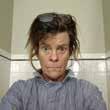


BRENDAN FERNANDES , as a multidisciplinary artist, examines issues of cultural displacement, migration, labor, and queer subjectivity through installation, video, sculpture, and dance. He is invested in confronting the complexities of transitional and transnational identities,


CHRIS BOGIA’s work reflects an ongoing interest in interior design and decorative art. As Bogia says, “My work sits in a queer space between contemporary art and decorative art, courting and resisting both worlds simultaneously”. Formally, Bogia’s work spans works on paper, textiles, and sculpture, frequently incorporating individually hand laid strands of yarn into the surfaces of his work. Thematically, Bogia says: “I like to work on a primary subject as a series for an extended amount of time like bonsai trees, fountains, or mandalas, contemplating their potential as cultural and poetic symbols while investigating their forms through repeated design and color iterations until I feel I have extracted and imbued enough depth of meaning and visual delight in equal measure.” Bogia received his BFA at New York University and MFA from Yale University. He currently lives in Queens, NY. Bogia is the recipient of a 2018 grant from the Pollack-Krasner Foundation, a 2018 Queens Council for the Arts grant, the 2017 Rema Hort Mann Foundation’s Artist Community Engagement Grant, the 2015 Tiffany Foundation grant, and was an artistin-resident at the Queens Museum Studio Program 2016-2018., Recent exhibitions include a 2021 public project with Art in Buildings in NYC, a solo presentation at Mrs. Gallery 2019, group exhibitions at Hesse Flatow, NYC, Primary, Miami, RUSCHMAN, Chicago, The Public Art Fund, NYC, Shulamit Nazarian, Los Angeles, Bric, Brooklyn, Mrs. Gallery, The New Museum, and a presentation at NADA with Mrs. Gallery in 2020. Bogia is the co-founder of Fire Island Artist Residency (FIAR), the first LGBTQ artist residency in the world, located in Cherry Grove, on Fire Island, and was FIAR’s acting director from 2011- 2020. He is currently an instructor of sculpture at New York University.
NANCE KLEHM has been an ecological systems designer, consultant, and agroecological grower for more than three decades. Her approach is centered on instigating change by activating already existent communities, and her work demonstrates her lifelong commitment to redefining the way human populations coexist with plant, animal and fungal systems on this planet.
Nance is internationally respected for her work on land politics and soil heath. Her work has received extensive national and international media coverage and has been mentioned in over 30 books. She is the author of The Soil Keepers: Interviews with practitioners on the ground beneath our feet (2019) and The Ground Rules: a manual to reconnect soil and soul (2016).
She currently splits her time between Little Village, a densely packed, diverse urban neighborhood in Chicago, and fifty acres in the Driftless Region, where she runs Chop Wood Carry Water Residency and cultivates and forages medicinal and edible plants, keeps bees and a fruit orchard, raises ducks and native quail, and grows for several indigenous seed banks.

HYUN JUNG JUN Born in South Korea
and based in Chicago, Hyun Jung Jun is an artist whose installations are measures and meditations which take up more time than they do space. Working with commonplace commodities such as candles, bread, wooden structures, Jun’s work borrows from familiar, domestic language to describe and search the ornate identities of our individuality and culture. In recent years, Jun has expanded her work to include edible forms in a cake project titled Dream Cake Test Kitchen Jun received her BFA at SAIC and an MFA in Art Theory and Practice at Northwestern University. Her recent exhibitions include Goldfinch, LVL3, the Gaylord & Dorothy Donnelly Foundation with Chicago Artists Coalition, No Place Gallery, Hans Gallery, The Drawing Room at Arts Club of Chicago and EXPO Chicago. Her work has been featured in Chicago Reader, the New York Times and Newcity Magazine. Jun is one of Newcity’s breakout artists for 2021.
42 2023 SUMMER COURSE CATALOG
1. Brendan Fernandes, Kinbaku IV, 2019, cast bronze, leather, walnut, and steel, 64 x 24 x 22 in.
2. LJ Roberts, Maggie Toth & Joaquín Ristorucci, 2020, embroidery on cotton, cloth size 7 ⅜ × 6 ⅝ in.

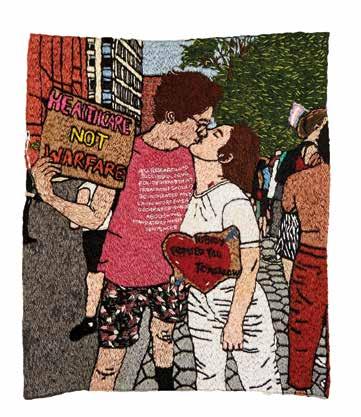
3. Chris Bogia, Moonlit Contraption, 2022, wood, lacquer, burlap, and paint
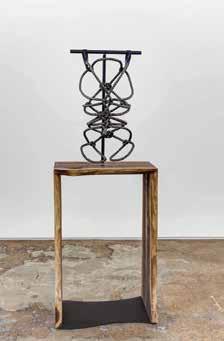

4. Tyson Reeder, Benetton, 2022, acrylic on canvas, 69 -53 in.
5. Jennifer Sullivan, Untitled (Kitchen Table Flowers), 2021, watercolor on paper, 24 x 18 in.
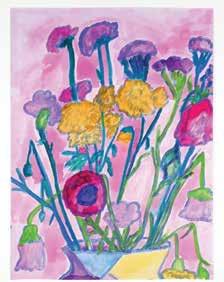
6. Hyun Jung Jun, Purple Swan, 2022, edible cake

7. Samantha Bittman, Interlace, 2018, custom digitally printed wallpaper, Museum of Art and Design Installation, NY, NY

43
Life at Ox-Bow


Frederick Fursman and Walter Clute, two faculty members from the School of the Art Institute of Chicago, founded Ox-Bow in 1910. Each summer, artists, students, and educators gather along the lagoon in beautiful Saugatuck, Michigan, located two and a half hours from Chicago. With programs that cater to degree-seeking students, professional artists, and those new to the field, Ox-Bow is a protected place where creative processes break down, reform, and mature. At Ox-Bow, we encourage you to experiment, take risks, be playful, and trust your instincts; to engage faculty and fellow students during course time and in our public spaces; to remain open to new experiences and contribute your unique perspective to our vital and historic community. During any given week, you will find:

• Students taking immersive classes
• Faculty from all over the world
• Renowned visiting artists, curators, and scholars
• Staff who are all working artists and have active studio practices
Frederick Fursman
Main Campus in Saugatuck, MI
44 2023 SUMMER COURSE
Ox-Bow House in Douglas, MI
CATALOG
JAMIE KELTER DAVIS
SAUGA-WHAT?
What, who, where is Saugatuck?
Saugatuck is nestled along Lake Michigan and the Kalamazoo River and is defined by rolling dunes and lush countrysides. Saugatuck is home to a small number of year round residents but is a prime summer getaway as the town comes to life in the warmer months.
LAUNDRY - Zoom Express Laundry
NATURE
- Saugatuck Dunes State Park
- Oval Beach
GROCERY STORES
- Demond’s Lake Vista Supervalu
- Isabel’s Market + Eatery
The
CAFES/COFFEE
- Uncommon Coffee Roasters

- The Farmhouse Deli & Pantry
- Pennyroyal Cafe & Provisions
PIZZA SLICES
- The Little Store
- Lakeview Convenience
ICE CREAM
- Dairy Dayz
- Palazzolo’s Gelati
Ox-Bow kitchen is the place to be!
FOLLOW US
@oxbow_hospitality
35,000+ MEALS MADE
2022 Party Themes
Goth Prom (a yearly tradition)
Dracula’s Foam Party
Demolition Furby
Gay for Clay
VOLLEYBALL GAMES
Volleyball is an age-old tradition at Ox-Bow. In some years fierce-friendly tourneys have been known to surface, and students and residents can easily round up a spontaneous match on the meadow on any given day.
CHICKEN AND BURGERS
-The Southerner
-Phil’s Bar and Grille
-Goog’s Pub and Grub
TACOS -Mi Favorita
-Tacos el Cuñado
-La Playa
Cowboy Christmas Sexy Swamp Ass
Sexy Noah’s Ark
All-Time Best Costume Creators
2022 WEDNESDAY EXTRACURRICULARS ORGANIZED BY KIR DONOVAN
Nature Walk with Billy Marie Peña
Creative Care Work: Rituals for BIPOC healing Workshop with Shakutake Eli Ryn Brown
Manifesting & Wellness with Rhonda Wheatley
Yoga on the Meadow with Marlee Mendelson
Stretch O’clock
Dance O’clock
DID YOU DO YOUR
DAILY TICK CHECK?
stats
from 2022
Witches and Wizards
Mike Andrews Lauren Anderson Jerry Catania
45 FROM NOUN PROJECT: MICHIGAN STATE ILLUSTRATION BY TED GRAJEDA; VOLLEYBALL BY MADE BY MADE, TICK BY PROSYMBOLS, AND DISCO BALL BY KMG DESIGN
COURSE SCHEDULE
Classes meet daily, 10 a.m. – 5:30 p.m.
COURSES & STUDIOS
Courses offer a unique opportunity to build your community by working closely alongside artists from across the country under the guidance of world-class instructors. Ox-Bow’s courses are diverse, ranging in focus from functional to sculptural; from traditional to contemporary; from representational to conceptual. Intensive and immersive one- and two-week courses allow students to delve deeply into their practices. All studios except glassblowing are open 24 hours. Ox-Bow maintains six classroom studios:
• Thiele Print Studio
• Haas Painting & Drawing Studio
• Seymour & Esther Padnos Metals Studio
• Krehbiel Ceramics Studio
• Burke Glass Studio
• Clute Papermaking Studio
ACTIVITIES & CAMPUS LIFE
There are always a number of activities to participate in around campus after course hours:
• Visiting Artist, Artist-in-Residence, and faculty lectures

• The Crow’s Nest Trail: Hike through 115 acres of wooded dunes

• Canoeing: Explore the lagoon and the beach along Lake Michigan
• Volleyball on the Meadow

• Relaxing around the campfire
• Spontaneous evening events
MEALS
Students enjoy healthy and delicious meals prepared each day by our talented kitchen staff. Locally sourced ingredients are used as much as possible. Three meals per day are included in the room-and-board fee for students residing at Ox-Bow. Our chefs are happy to accommodate dietary restrictions; please let the Ox-Bow office know of any food allergies or special diet requirements upon check-in. Please refer to the COVID-19 Community Guidelines for more information on meal service.
HOUSING
Ox-Bow provides dormitory-style housing with shared bathrooms. Students may choose shared or single room accommodations.
COMMUTING STUDENTS
Students with other housing arrangements may commute to campus and will be assessed $75 per day for a meal plan. Camping is not allowed at Ox-Bow.

CONTACT INFORMATION
Questions concerning your stay at Ox-Bow (arriving, departing, what to bring, travel issues, etc.) should be directed to the Saugatuck office at (269) 857-5811. The Ox-Bow campus is located at 3435 Rupprecht Way, Saugatuck, MI 49453. Questions regarding class registration and payment should be directed to the Programs Manager at oxbow@ox-bow.org.
46 2023 SUMMER COURSE CATALOG
HAI-WEN LIN, ROWAN LEEK; ALANNA HUCK-SCARRY
DID YOU KNOW...
There are appromiately 100 painted chairs on campus! We're not sure who started the tradition (if you know, let us know) but the earliest dated chair is from 1988. To ensure the chairs have a long life span, John Rossi, estimates around 30-50 repairs per year. The next time you are on campus, take a closer look at the collection of chairs. And, if you see an unpainted chair, it is fair game for any to paint!
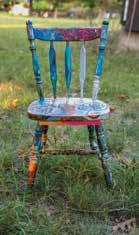







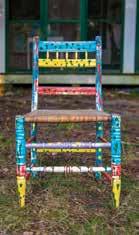


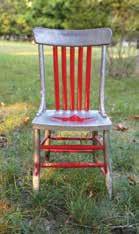






47
DEECY SMITH
DR. JEDLICKA – KNOWN FONDLY BY MANY STUDENTS AS DR. DJ – has taught various science courses at Ox-Bow for the past twenty-five years. “It’s a miracle because I’m only twenty-three,” she jokes. She’s off the clock for our conversation, just about to haul some scones out of the oven. They’re ginger molasses, fitting for the windy November day, and she’s planning on walking them over to the neighbors after our phone call. “I made pumpkin ones earlier this week,” she says, “But folks ate them all, so I had to make more.” One gets the impression this isn’t that rare of an instance, that she’s baking scones for her neighbors (and maybe even students) on the regular.
Dr. Jedlicka describes herself as a “functional biologist for morphologists,” and her number one rule is “always make sure you have fun.” During the summer of 2023, Dr. DJ’s course will focus on ornithology, but she has more playfully dubbed it “Bird Science.” Over the two-week session, artists will be introduced to the variety of woodpeckers, warblers, and meadowlarks that call the woods and meadow home. Each day will host its own variety, not just of wildlife, but activities too. In addition to traditional readings and lectures, students should expect to lace up their hiking boots. While some afternoons might include a field trip to the zoo or Frederik Meijer Gardens, others include a morning of lab work on the beach or an afternoon hike through the Tallmadge Woods.

Committed to setting her students up for success, and not just by adhering to her rule number one, Dr. Jedlicka recognizes, “This might be [a student’s] last science course… I want to give them a good foundation.” It seems she has not fallen short on this goal. A number of Jedlicka’s students have gone on to be published through the research they conducted in her course, but it’s not these achievements she cares about most. “What I like with nonscience people, especially artists, is to see the light bulbs go on,” says Jedlicka. She notes a clear connection between the complex thinking that students must engage with in her classes and the arts, and even recognizes creative thinking as one of her own artistic practices.
With a PhD in Biological Science and twenty-five summers at Ox-Bow to boot, Dr. Jedlicka is more familiar with the Tallmadge Woods than most anyone else. She shares that one of her favorite encounters on campus was with the pileated woodpecker during the summer of 2020. The campus, due to the pandemic, was closed to all visitors and students. Dr. Jedlicka, however, received a special invitation to stay on campus while she taught a virtual student body. Some wildlife had crept in closer to the edge of the trail, which lacked the usual foot traffic of students and locals. Amongst these emboldened creatures were two pileated woodpeckers, typically so elusive, which had built their nest directly alongside the trail. Though no longer inhabited, the nest is still present and visible to the trained eye, and if you’re lucky enough to hike through the Tallmadge Woods with Dr. Jedlicka this summer, I suspect she’ll happily point it out to you.
ARE YOU A TRUE BIRDER?
Ox-Bow is home to a plethora of birds. You can often see them out on the meadow, in the lagoon, and they’ll often be the first voices chattering around campus each morning. Local data suggests nearly 200 species pass through or make their home in our neighboring dunes, wetland, and forest.
Use our guide to familiarize yourself with your avian neighbors! Who knows, by the end of your time here you might be able to call yourself a True Birder.
HOW MANY SPECIES CAN YOU SPOT DURING YOUR TIME ON CAMPUS?
Check your score below to claim your title!
MALLARD DUCK

This species belongs to a subgroup of ducks called dabbling ducks. These dabblers can often be spotted on the lagoon as they dip their head to collect the abundance of algae that grows in its water. Males have an iridescent green head with a white ring at the base of the neck, while females sport mottledbrown plumage.
BARRED OWL

Barred owls are a common player in the forest’s ecosystem. Though their buffy feathers and white mottling are rarely seen, these birds are often heard. You can recognize them by their call, which sounds like they’re asking, “Who cooks for you all?”
BELTED KINGFISHER

Look for these blue-gray birds as you take a canoe out on the lagoon. They can be seen diving from the treeline to the water in an attempt to catch fish. Males and females can be distinguished by the female’s chestnut band that splits their white chests.
1/8 - THE HATCHLING
You must only have eyes for the robins!
3/8 - THE CLASSICIST


After your time at Ox-Bow, you can spot mallards, robins, and chickadees from a mile away.
5/8 - THE FLEDGLING
This birder is about to leave the nest. You really know your stuff and your skills are ready to take flight!
7/8 - A TRUE BIRDER
ROBIN
The American Robin might seem commonplace to Midwesterners, but its markings are still quite striking. These red-breasted birds love hunting for worms with their orange beaks and they’re one of the first voices you’ll hear singing on campus each morning.

BLACK-CAPPED CHICKADEE

These brave little birds hang around Michigan all winter to hunt for insects, berries, and seeds. You can recognize them by their white cheek that sticks out against their black cap and bib. Their oat colored chest (often described by birders as buffy) distinguishes them from the look-alike Carolina Chickadee.
NORTHERN FLICKER

If you see a flash of gray and yellow jet by, you may have just spotted your first Northern Flicker, a member of the woodpecker family. These birds boast a grayish brown body with black stripes on their back and freckles on the chest. Red and blue-gray markings can be seen on their peachtoned face.
The elusive tanangers and pileated woodpecker are no match for your skills. You leave Ox-Bow no longer just an Artist… but a True Birder as well!
SCARLET TANAGER

You can recognize these birds by their scarlet red bodies and black wings. They look similar to their southern relatives, the summer tanager.
PILEATED WOODPECKER

The Pileated Woodpecker is a crowd favorite. This bird has a loud cry that sounds truly prehistoric. Equally as striking is their red-tufted cap of feathers and yellow eye.
DR. DJ’S CHALLENGE
Spend a half an hour watching a bird on the meadow. What do you notice about its behaviors? Have you learned anything new?
49 2023 SUMMER COURSE CATALOG UNSPLASH:
OWL
BELTED KINGFISHER,
GAURAVDEEP SINGH BANSAL; BARRED
, PILEATED WOODPECKER, AND NORTHERN FLICKER BY PATRICE BOUCHARD; SCARLET TANAGER,
AND MALLARD DUCK BY JOSHUA J. COTTEN; BLACK-CAPPED CHICKADEE BY DEREK OTWAY; ROBIN BY KIERAN MANION
ASTRO FORECAST SUMMER 2023
The lunar nodes change signs July 17th, with the north node of destiny moving into Aries, the sign of battle, while the south node moves into Libra, the sign of balance. The node cycle is a constant tension between two opposites, the head (north node) eating the tail (south node) like an ouroboros. The north node is symbolic of our destiny or deep, soul-driven desires. Think of it as your north star: where are you headed and how?
Aries, ruled by fiery Mars, is the first sign of the zodiac and rules the 1st house: the house of self! The first house represents a person’s identity – from appearance to temperament – and is defined by the rising sign. With the north node in Aries, the summer will kick off an 18-month cycle where we are all challenged to consider the “I” and the “we”. What house Aries is in in our personal charts will help us understand which areas of life this applies to. With the north node in an Aries’ house, our “I” will be saying: “Look here! See me!” But while we strive to satisfy our ego, we need to be careful that we don’t throw others into the shadows, or worse, under the bus.
If you know your rising sign, you can figure out which house Aries is in your chart by counting forward from that sign. i.e. if Scorpio is in your first house, it is your rising sign and Aries is six signs after Scorpio, placing it in the 6th house. The following horoscopes should be read for your rising sign (the sign that is in the first house of your natal chart) and are meant as fun guidance for the nodal transition as we collectively navigate the “I” and “we” this summer!
The north node will pull into your 9th house of learning and spiritual expansion, so if you’ve been thinking of exploring new studies or building a new skill, this astrology is supporting that destiny! Dig in now and watch your world expand!
As the north node enters your 8th house you might find yourself feeling possessive and fearing loss, but remember that south node in Libra, your second house: you have a lot of personal value! Hold things lightly, and let go of a scarcity mindset.
With a 7th house Aries you were already driven. But with the north node arrival, the next 18 months' challenge to you see how you get there together and stop going it alone.
Have you been trying to start a fitness or health routine since…waaaay back? This might be your year with the north node arriving in your 6th house of health, wellness and daily routines. The north node is going to support you in buckling down and getting the everyday to be the life you have long been trying to build.
The north node of destiny enters Aries in July and sets you on a path for re-emergence! For the next 18 months the node of destiny will be in your first house, pushing you to step into your powerful “I”; at the same time the south node in your 7th house of relationships reminds you that no one is an island.
The north node will be lurking in your 12th house: the end of the cycle. If you think of the astrological houses as the circle of birth/death/rejuvenation, the 12th house is the soil from which the next cycle will be birthed. With the north node in this part of a chart, pay attention to the subconscious, record your dreams and do your shadow work.
With a 5th house Aries, you already spend a lot of your time being creative (that’s why you’re reading this catalog, right?), so with the north node settling in for 18 months you are about to experience a wild ride in your creative and pleasure practices. This might be the year your online shop blows up or you land some press that shines a spotlight on your talents.
You probably already have a feisty home life with an Aries fourth house. Doubling down with a visit from the north node suggests that some things you have been longing for in that sphere are finally in the cards.
The north node is stirring up your 11th house of friendships and the collective while the south node is keeping things balanced in your 5th house of pleasure, love and creativity, reminding you to fuel your private fires in order to stoke the communal ones. You might find yourself leading a group or at the very least, fomenting some collective creativity – maybe it’s time to start that band?
Your 10th house is in Aries, the house of career and public image. The north node is going to challenge you to show up and distinguish yourself in your professional ambitions, just don’t forget about the 4th house – the house of home and family where the south node will be: a nurtured private life helps keep your public one in balance.
AQUARIUS

An Aries 3rd house means you are a passionate communicator so this nodal transit is going to dial that up a few notches as it traverses your 3rd house of intellect and communication. You will be driven to get your ideas into the world, but that south node reminds you to check your citations, get an editor, and make sure to give credit where credit is due.
With an Aries 2nd house, you are a go-getter who knows your value. This next 18 months promise strides in this area –whether you negotiate a raise or sell your first painting – you will be defining your worth and what material gains you do or do not want to tied to that.
ARIES
GEMINI
TAURUS CANCER
LEO
LIBRA
VIRGO
SCORPIO
SAGITTARIUS CAPRICORN
PISCES
50
Astrology by Shannon Stratton, Ox-Bow Executive Director and amateur astrologer.

Learn more about Ox-Bow from our interactive map! Includes playlists, zines, videos, & much more. Scan QR code to access the map, password = hotdogs 1 2 3 4 1 2 3 4 5 5 6 7 8 9 10 6 7 8 9 10 11 12 11 12 13 13 THE INN THIELE PRINT STUDIO CLUTE PAPERMAKING STUDIO THE MEADOW HAAS PAINTING & DRAWING STUDIO CROW'S NEST THE JANIE (NOT SHOWN) SEYMOUR & ESTHER PADNOS METALS STUDIO LAGOON THE MARSHALL KREHBIEL CERAMICS STUDIO THE WET BURKE GLASS STUDIO
BY
51 2023 SUMMER COURSE CATALOG
MAP
DOVE HORNBUCKLE
REGISTRATION & TUITION
All Ox-Bow Core Classes are open to any participant over 18 for registration. Inperson registration begins at 8:30 a.m on Monday, March 27, 2023 in the Neiman Center, 37 S. Wabash.
After 9:00 a.m on Monday, March 27, 2023, your registration request can be submitted to the Ox-Bow registrar via the form on our website. Classes are available on a first-come-first-served basis.
Students who complete a for-credit course will receive credit through the School of the Art Institute of Chicago. Ox-Bow’s for-credit tuition is the same as SAIC’s per credit. Students may also be able to use their financial aid award from SAIC toward degree credit tuition for courses.
Please note, Ox-Bow’s registrar does not work from Ox-Bow’s campus in Saugatuck, MI and will not be available via the campus phone. Any questions regarding registration should be directed to, oxbow@ox-bow.org.
SCHOLARSHIPS
OX-BOW MERIT SCHOLARSHIPS
Merit Scholarship Funds are available to apply toward any core class. Awards are typically partial. The scholarship deadline is Sunday, March 12, 2023, at midnight. Apply online at www.ox-bow.org.
OX-BOW WORK SCHOLARSHIPS
Scan the QR Code to access to the registration page. Prefer not to register online? Please contact oxbow@ox-bow.org and we will happily set up an appointment to process your registration over the phone.
ROOM & BOARD
An essential part of the magic of Ox-Bow is getting to know its domestic architecture, sharing meals, and living amongst fellow students, faculty, and staff. Room & Board fees cover lodging during the session and three meals per day.
Room & Board costs are available in two tiers to accommodate those who would prefer a single room. Single Rooms are limited and we encourage those interested to register quickly.


Ox-Bow will award a number of work scholarships on a first come, firstserved basis to interested students. The work scholarship is equivalent to the cost of shared room and board while attending Ox-Bow. Students work 15 hours per week while on campus in one of the following jobs: kitchen, housekeeping, or grounds and maintenance. Work scholarships can only be claimed in person at Ox-Bow’s registration event in the Neiman Center starting at 8:30 a.m. CST March 27, 2023.
BEA AND CAROLINE DAVIS SCHOLARSHIP: Available to all students. Credit or non-credit courses.
BEN SEAMONS MEMORIAL SCHOLARSHIP: Available to all students. Credit or non-credit courses.
DALE METTERNICH MEMORIAL SCHOLARSHIP : For undergraduate and graduate studentsfrom any school. Credit or non-credit courses.
DANIEL CLARKE JOHNSON MEMORIAL SCHOLARSHIP: For undergraduate and graduate students from any school. Credit or non-credit courses.
DAVE BALAS SCHOLARSHIP: Available to all students. Credit or non-credit courses.
FITZ AND THELMA COGHLIN SCHOLARSHIP: For students from the West Michigan region. Credit or noncredit courses.
GEORGE LIEBERT SCHOLARSHIP: For undergraduate and graduate students from any school. Credit courses only.
JIM ZANZI SCHOLARSHIP FUND: For SAIC students to take classes at Ox-Bow.
NON-CREDIT SHARED ROOM & BOARD FOR-CREDIT SINGLE ROOM & BOARD FOR-CREDIT UNDERGRAD GRAD $2,678 $1,290 $2,790 $5,355 $2,795 $5,580 1-WEEK 1-WEEK $900 $900 2-WEEKS 2-WEEKS $1,800 $1,950
52 2023 SUMMER COURSE CATALOG
Granted on the basis of financial need. Credit courses only.
LALLA ANNE CRITZ ZANZI
SCHOLARSHIP: For female SAIC undergraduate and graduate painting students. Credit courses only.
LEROY NEIMAN FOUNDATION
SCHOLARSHIP: For undergraduate and graduate students from any school. Credit or non-credit courses.
LORETTA GRELLNER SCHOLARSHIP: For adult women who are either pursuing a degree in art or seeking to refresh their professional practice in the classroom environment. Credit or noncredit courses.
MARY LOUISE BARNA MEMORIAL SCHOLARSHIP: For degree-seeking students from any college or university with demonstrated financial need, who would be unable to attend Ox-Bow without the support of this scholarship. Credit courses only.
RUPPRECHT SCHOLARSHIP: For undergraduate and graduate students currently enrolled in SAIC’s Painting and Drawing programs. Credit courses only.
STEKETEE SCHOLARSHIP: For SAIC undergraduate and graduate students. Credit or non-credit courses.
THE TIPPING MEMORIAL FUND: A yearly award to an outstanding high school art student, on the basis of need as well as merit.
VI FOGLE URETZ SCHOLARSHIP: For SAIC undergraduate and graduate students. Credit or non-credit courses.
WEST MICHIGAN SCHOLARSHIP: For students residing within the West Michigan area. Support provided in part by the Wege Foundation. Credit or non-credit courses.
* Only one application is required to apply for all available scholarships.
POLICIES
DROP POLICY
PLEASE READ CAREFULLY, OX-BOW’S DROP POLICY IS NOT THE SAME AS SAIC’S DROP POLICY.
Refunds can only be granted if drop requests are made three weeks prior to the beginning of the class. All drops must be submitted in writing to Ox- Bow at oxbow@ox-bow.org . From the time of registration to three weeks before the start of your class, students will receive a full refund minus $250 and any associated lab fees. If dropped after three weeks before the start of class, no refunds will be given. In cases of a documented emergency, students may go through SAIC’s refund review process.
Due to our COVID-19 community guidelines, all participants must be tested for COVID-19 72 hours prior to coming to campus. If any participant tests positive they will not be able to attend and therefore will be fully refunded with no associated drop fees (written notification and proof of test results within 5 days of the first day of class will be required).
Ox-Bow is dedicated to providing students with the experience described in the catalog, but cannot guarantee the listed faculty. In the rare event that a faculty cannot instruct their class, a replacement of similar expertise will be provided. Faculty replacement does not make a student eligible for a refund.
In the event that Ox-Bow must cancel a course for any reason, a full refund will be given.
Ox-Bow reserves the right to evolve this drop policy at any time per evolving COVID-19 Guidelines and recommendations.
ADMISSION POLICY
Ox-Bow reserves the right to deny admission to any individual who has demonstrated a history of behavior that, in the judgment of Ox-Bow, might contribute in any way to the disruption of the educational processes or residential life on campus.
COMPANION/GUEST POLICY
No companions, guests, dependent children, or visitors are permitted during your stay. All residential housing and studio facilities are limited to artists enrolled in courses. We may be able to assist participants in finding accommodations for individual family circumstances, but these arrangements will be made on a case-by-case basis and must be determined in advance of your course or residency. There is no guarantee that alternate accommodations can be established.
SUSPENSION & EXPULSION POLICIES
Ox-Bow reserves the right to impose sanctions including suspension and expulsion, without refund, upon students whose behavior, in the judgment of Ox-Bow, contributes in any way to the disruption of the educational processes or residential life on campus. Additional policies are listed in the Ox-Bow Policy & Procedures Handbook. (SAIC students will be subject to disciplinary procedures and sanctions as outlined in the School of the Art Institute of Chicago’s Student Handbook).
STUDIO POLICIES
Each studio has specific policies in place to ensure the safety of students and equipment. Additionally, these policies ensure that all participants receive a quality education with equal access to faculty and equipment. All studio-specific policies will be explained on the first day of classes. Any student found in violation of these policies will be asked to leave the course without refund. These same policies are applied to any work conducted in the Ox-Bow landscape or on the Ox-Bow grounds. Because Ox-Bow is a community, we ask that all students respect the rights of their classmates and fellow community members by following our policies.
53 2023 SUMMER COURSE CATALOG
COVID-19 COMMUNITY GUIDELINES
Our COVID-19 Community Guidelines were updated in September 2022. Ox-Bow reserves the right to amend this policy at any time given outbreak trends or CDC guidance.
In order to mitigate the risks and spread of COVID-19, we have implemented new safety measures on campus. We ask that all community members follow the guidelines and best practices below.
Effective September 15, 2021, Ox-Bow School of Art and Artists’ Residency requires every participant who stays overnight on campus to submit proof of full and current vaccination, unless they cannot do so due to a religious or medical reason or other authorized exception. This requirement pertains to everyone staying overnight on campus, including staff, students, faculty, artists-in-residence and other guests.
All fully-vaccinated overnight guests on campus are required to submit a COVID-19 test 72 hours prior to arrival, and submit proof of a negative result to the Campus Director before traveling to campus.
You will receive a questionnaire, to be filled out 48 hours prior to arrival on campus, confirming that you have not been exposed to COVID-19 and are not currently experiencing any symptoms. You will be asked to upload your proof of vaccination and negative COVID-19 test results on this form.
The campus office stocks over-thecounter COVID-19 tests; they are available to students and overnight participants, free, on demand.
If any participant is experiencing symptoms that may indicate a COVID-19 infection while staying on campus, the Campus Director may require an over-thecounter COVID test or a lab test from a local free testing site.
TRANSPORTATION
Please note that all students are responsible for arranging their own travel to and from campus.
• We encourage participants to use personal or rented vehicle if possible. Enterprise, Avis, Hertz, and Budget all have locations in Holland, Michigan, an approximately 20-minute drive from campus. Check with the individual
agency to see if they accept vehicle drop-offs. Ox-Bow can coordinate pickup from the rental drop-off point for residential students only upon arrival to campus, not upon departure.
• If using public transportation, use Amtrak. Ox-Bow will coordinate transportation to and from the train station for residential students only upon arrival and departure.
• Wear cloth face coverings/masks while traveling.
GENERAL COMMUNITY GUIDELINES
• Practice proper hand washing.
• Socially distance, staying at least 6 feet apart from others, whenever possible.
• Properly cover your mouth and nose when coughing and sneezing.
MASK POLICY
• Cloth, surgical or N95-style masks are required whenever you are retrieving food in the New Inn dining room, as well as when you deliver used dishes to the dish area.
• We ask that if you have recently traveled via airplane, mask when indoors for 3-5 days while you monitor the development of any potential symptoms
• Otherwise, Ox-Bow is a mask-friendly, mask-optional campus
• Disposable masks are available free of charge in the Old Inn
• COVID-19 at-home tests are available free of charge for participants upon request from Old Inn Office staff
SPACES
• We have implemented heightened sanitation of high-traffic areas.
• Whenever possible, workshops and events will take place in sheltered outdoor/open-air spaces for maximum ventilation.
• We will ensure that windows and doors with screens remain open as much as possible, keep fans running, and maximize airflow and ventilation.
• In the warmer months, open-air tents on the Meadow facilitate outdoor gatherings.
DINING
• Masks are required whenever you are retrieving food in the New Inn dining room, as well as when you return used dishes.
• Please space out 6’ apart when waiting in line and retrieving food.
• Use provided hand sanitizer before retrieving food.
• Grab-and-go snacks will be available for residential participants between meals.
• Participants must return their own used dishes.
• Food service practices will evolve as necessary.
CLEANING
• Housekeeping staff use antiviral cleaning agents for all cleaning purposes.
• Housekeeping staff clean and disinfect public bathrooms and other high-traffic areas daily.
• DIY cleaning materials will be available upon request. All community members will be expected to pitch in to keep themselves and their spaces clean.
• All public bathrooms are equipped with paper towel dispensers.
• Hand sanitizer dispensers are available in high-traffic areas.
IN CASE OF ILLNESS
• All community members will be asked to familiarize themselves with COVID-19 symptoms; we will make this information available through orientations, as well as postings on our website and on campus. We will also provide printouts with detailed information about local medical facilities.
• If you are experiencing symptoms, tell core staff immediately.
• Staff will take the temperature of any student demonstrating potential COVID-19 symptoms.
• Any participants with COVID-19-like symptoms (cough and fever) maybe asked to leave campus and seek medical care at the Campus Director’s discretion. Any participants testing positive for COVID-19 will be asked to isolate and to exit campus as soon as possible. Ox-Bow cannot provide quarantine space for participants who test positive for COVID-19.
• If a confirmed case of COVID-19 or COVID-19-like symptoms are exhibited by anyone currently on campus, Ox-Bow reserves the right to actions, including immediate closure of our campus and/or providing COVID-19 testing to staff and participants. In the case of any closures, we will assist in making arrangements to have participants leave campus.
• Ox-Bow will work with the required outside health departments for contact tracing.
• Ox-Bow’s staff cannot provide medical care or transportation to a care facility.
54
SUMMER ARTIST-INRESIDENCE PROGRAM

Ox-Bow’s fully-funded Summer Residency Program offers 12 artists the time, space, and community to encourage growth and experimentation in their practice for three weeks on campus. The Summer Residencies are held while our core classes and community programs are in session. During this time, a small group of residents have access to Ox-Bow’s artist community of students, faculty, and visiting artists.
Our Summer Residencies are open to artists or writers at any level. Currently enrolled students, MFA candidates, arts faculty, emerging, or established artists are encouraged to apply. There are generally three residents on campus at a time.
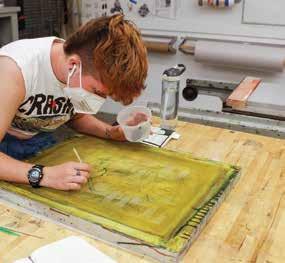
2023 DATES AVAILABLE ARE;
• May 28 - June 17
• June 18 - July 8
• July 10 - 29
• July 30 - August 19
• RESIDENCY RECIPIENTS RECEIVE:
• A studio space with 24 hour access
• Housing and 3 meals per day
• Weekly studio visits with visiting artists

• Opportunity to exhibit their work
Applications are due February 26, 2023 by midnight
55 HAI-WEN LIN, 2022 LEROY NEIMAN FELLOW 2023 SUMMER COURSE CATALOG
PRE-COLLEGE PROGRAM
Ox-Bow’s Pre-College program is a one-week skill-building class designed for advanced high school juniors, seniors and recent graduates who are considering pursuing a degree in the visual arts. The pre-college program was founded by the late E.W. Ross, who served Ox-Bow for over 35 years as Faculty, Program Director, and later Board Member. Enrolled students are given the opportunity to evaluate and strengthen their commitment to the study of art, receive college level instruction, and receive 1.5 college credits through the School of the Art Institute of Chicago. Ox-Bow’s core academic program runs concurrently with these courses, providing Pre-College students with a sense of community as they interact with other artists taking classes.
In 2023, the Pre-College program returns reimagined with a new curriculum. Under the guidance of Campus Director, Claire Arctander, students will be challenged and encouraged to understand art-making as a holistic, ongoing practice for both career and life fulfillment.
WHY WE ART: COLLABORATIVE CONCEPT EXPANSION FOR ADVANCED HIGH SCHOOL ARTISTS
with Claire Arctander
PAINTING | 402 001 | 1.5 CREDITS | $50 LAB FEE
This pre-college class will encourage individual and collective explorations in developing an art practice. We will identify methods of concept-building by playfully addressing our own interior lives, the immediate environment of Ox-Bow, and broader societal contexts. We will establish a community in which we draw from observation, make found object & soft sculptures, and site-specific installations to investigate our current situation. We will glean inspiration from the works of artists such as Theaster Gates and Yayoi Kusama and readings and screenings will include Emergent Strategy by Adrienne Maree Brown, The Artist As Collector by Lydia Yee and Mika Rottenberg’s Cosmic Generator. Students will gain formal skills in organizing marks and objects into coherent artworks, conceptual skills in honing strong reasons behind their art-making practice, and collaborative skills of idea exchange. Students will decide upon a central question and present a collaborative group show of works responding to that theme. The students’ interests and priorities will help dictate the direction of the course and the resulting exhibition.




CLAIRE ARCTANDER is an interdisciplinary artist, educator and administrator whose making practice plays in the aesthetics of desire, physicality, conflicted feminisms, craft traditions, material transformations, and collaboration. As Ox-Bow's Campus Director, Arctander oversees on-campus operations; tends to the experience of students, residents, and staff; and programs the Art on the Meadow community-facing workshop series. She teaches and leads from a participatory and inquiry-based premise. Arctander has previously worked in the field of art education at the Museum of Contemporary Art Chicago, Weinberg/Newton Gallery, the University of Illinois Chicago, the City Colleges of Chicago, and Northwestern University. Her work has been exhibited at Ruschman Gallery in Chicago; the Terrain Biennial in Oak Park, IL; Hyde Park Art Center in Chicago; Lula Café in Chicago; Franklin Street Works in Stamford, CT; nGbK in Berlin; Thalia Hall in Chicago; The Cell in New York; The Nightingale in Chicago; UnionDocs in New York; Artists’ Television Access in San Francisco; Omni Commons in Oakland; Spektrum in Berlin; University of Southern California’s 3001 Gallery; the Museum of Contemporary Art Chicago; and other locations.
Funding Opportunities are available through the
Ross and Tipping Scholarships
SESSION FIVE - July 23 - 29 (1 week)
E.W.
56 2023 SUMMER COURSE CATALOG
Claire Arctander, Exterior Scroll, 2019, vintage toilet paper and yarn, 100” x 40” x 5”
OUR PROGRAMMING SUPPORTERS
EFROYMSON FAMILY FUND

This project was funded in part by a grant from the Efroymson Family Fund.The Efroymson Family Fund, a donor- advised fund of the Central IndianaCommunity Foundation, continues a long legacy of charitable commitment by the Efroymson family in central Indiana. The Efroymson Family Fund was established in 1998 by Dan and Lori Efroymson to promote the visibility of communities and to date has awarded more than $88 million in grants in central Indiana and beyond. We are grateful to the Efroymson Family Fund for their support of our Visiting Artists Program. For more information about theEfroymson Family Fund, visit: efroymsonfamilyfund.org
JOHN M. HARTIGAN MEMORIAL SCHOLARSHIP FOR PAINTERS



John M. Hartigan was a life-long Chicagoan, an artist, a patron of the arts,and a dedicated family man. A gifted lawyer and an engaged community member, John was always interested in civic affairs, sitting on a number ofBoards. Over the years he took courses at the School of the Art Institute, as well as Summer courses at Ox-Bow. John loved both the camaraderie and the artistic synergy of the campus. The Hartigan Endowment will be used to support the on-going education of artist in residence whose medium is acrylic and/or oil. This award is available to applicants for both the Summer andFall Residency cycles.

57
JAMIE KELTER DAVIS
3435 Rupprecht Way P.O. Box 216 Saugatuck, MI 49453













 Our campus sits on the TALLMADGE WOODS
Our campus sits on the TALLMADGE WOODS


























 (clockwise from top left)
1. William Sieruta, Rainbow Trout , oil on panel, 25 x 22 in.
2. Scott Reeder, Bread & Butter (Hot Tub w/ Sunset), 2022, oil on canvas, 24 x 36 in., Courtesy of CANADA gallery NYC
3. Rachel Niffenegger, Wraith 4 , 2021, dye sublimation on brushed aluminum chroma luxe panel, frame mount, 36 x 36 in.
(clockwise from top left)
1. William Sieruta, Rainbow Trout , oil on panel, 25 x 22 in.
2. Scott Reeder, Bread & Butter (Hot Tub w/ Sunset), 2022, oil on canvas, 24 x 36 in., Courtesy of CANADA gallery NYC
3. Rachel Niffenegger, Wraith 4 , 2021, dye sublimation on brushed aluminum chroma luxe panel, frame mount, 36 x 36 in.




 1. Laurel Sparks, Mercury, 2020, poured gesso, waterbased paint, ash, paper pulp, glitter, holes, collage, woven canvas strips, 28 x 28 in.
2. Joseph Mario Romano, Empty Bird Feeder 3, 2017, watercolor, 10 x 10 in.
3. Josh Dihle, Vision, 2020, rocks, fossils, and oil on canvas, 18 x 14 in.
4. Carrie Gundersdorf, Ivory Cone , 2022, blue-violet-grey, colored pencil and watercolor on paper, 24 x 21 in.
1. Laurel Sparks, Mercury, 2020, poured gesso, waterbased paint, ash, paper pulp, glitter, holes, collage, woven canvas strips, 28 x 28 in.
2. Joseph Mario Romano, Empty Bird Feeder 3, 2017, watercolor, 10 x 10 in.
3. Josh Dihle, Vision, 2020, rocks, fossils, and oil on canvas, 18 x 14 in.
4. Carrie Gundersdorf, Ivory Cone , 2022, blue-violet-grey, colored pencil and watercolor on paper, 24 x 21 in.







 (left to right) 1. Jessica Gatlin, Abode: Contemporary Art & Craft Exhibition Space, Tithes & Offerings , 2021, artworks by Abigail Lucien, Sam Dunson, Anna Wehrwein, and TaO, size variable; 2. Brandon J. Donahue, Basketball Bloom (NCAA Mask), 2017, searched for and found basketballs, shoestrings, 3 x 4 x 2 ft. ; 3. Madeleine Aguilar, door bell, 2021, steel pipe, nylon mason line, and wooden mallet, 8x 2 1/2 x 1 in.; 4. bex ya yolk, O rigami Diamond Book , 2020, Neenah 80 lbs cardstock paper, book cloth, book board, linen 18/3 thread, PVA, Velcro, 16 3/4 x 3 in. (extended); 5. Danny Miller, Zombie Satellite #1, 2022 , crayon, acrylic and graphite on paper, 22 x 18 in.; 6. Kristina Paabus, Impossible Too, 2021, wood lithography, aquatint, and screenprint, 24 x 20 in.;
(left to right) 1. Jessica Gatlin, Abode: Contemporary Art & Craft Exhibition Space, Tithes & Offerings , 2021, artworks by Abigail Lucien, Sam Dunson, Anna Wehrwein, and TaO, size variable; 2. Brandon J. Donahue, Basketball Bloom (NCAA Mask), 2017, searched for and found basketballs, shoestrings, 3 x 4 x 2 ft. ; 3. Madeleine Aguilar, door bell, 2021, steel pipe, nylon mason line, and wooden mallet, 8x 2 1/2 x 1 in.; 4. bex ya yolk, O rigami Diamond Book , 2020, Neenah 80 lbs cardstock paper, book cloth, book board, linen 18/3 thread, PVA, Velcro, 16 3/4 x 3 in. (extended); 5. Danny Miller, Zombie Satellite #1, 2022 , crayon, acrylic and graphite on paper, 22 x 18 in.; 6. Kristina Paabus, Impossible Too, 2021, wood lithography, aquatint, and screenprint, 24 x 20 in.;

























 WRITTEN BY: SHANLEY POOLE // PHOTOGRAPHY BY: YEJI KIM
WRITTEN BY: SHANLEY POOLE // PHOTOGRAPHY BY: YEJI KIM









































































 1. Melina Ausikaitis, Shirt Back, 2020, singles installation, Regards, Chicago, IL, 4 x 5 ft.
1. Melina Ausikaitis, Shirt Back, 2020, singles installation, Regards, Chicago, IL, 4 x 5 ft.
















































































